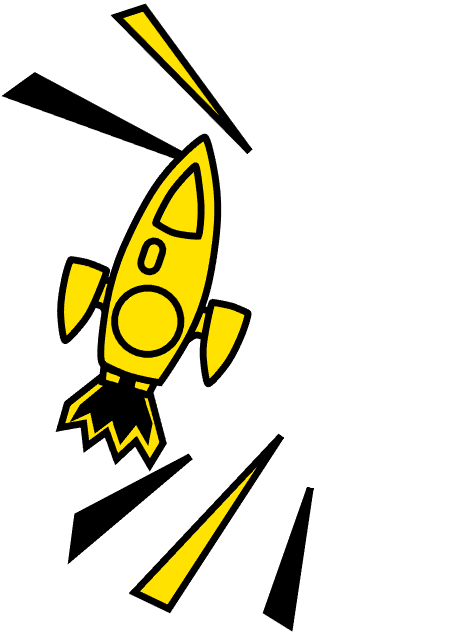
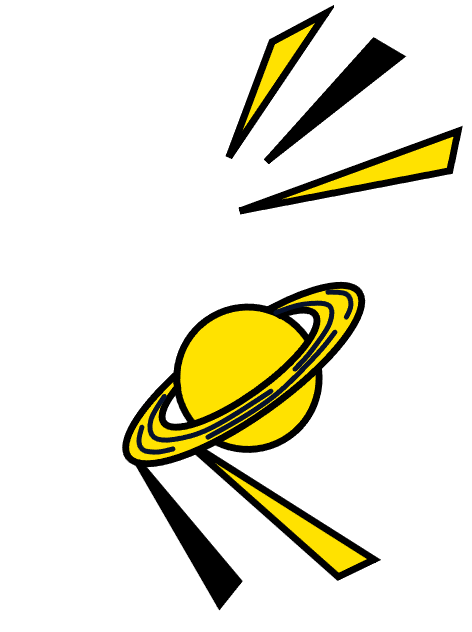
Wrap-up
Congratulations to the 147 teams to save Matt & Emma’s Deep-space Disaster!
- 71 teams achieved the 👽Alien ending by signaling the Podomorphs for help
- 51 teams achieved the 📍Navigation ending by plotting a course to Marsh Haven
- 25 teams achieved the 🪴Greenhouse ending by restoring the ship's life support
Additionally, congrats to the
- 603 teams to solve at least one puzzle
- 483 teams to solve at least one capstone
See more stats here!
We are thrilled you could join us on this adventure. The rest of this wrap-up will contain heavy spoilers for the hunt. You have been warned.
Theme & Story
Story and Puzzle Co-Design
Our primary design goal for this hunt was:
The puzzles and structure are the medium for story/theme. People should experience whatever theme or plot we design through simply solving the hunt normally.
We had 6 themes in our voting phase, with the branching structure proposal (under the working title of Starship Saga) taking first place. We liked that it allowed us to create a cohesive experience and to innovate on the structure beyond what has been done with the time travel trope (GPH 22, PHCMU Fall 2018). The original proposal included a general structure graph featuring 3 main endings, a vent-like bypass, and an early detour to fix something critical for reaching a good ending (what became the reactor).
We split into groups for designing individual rounds (and usually, but not always, writing the capstone). These rounds were placed in the branching graph as their ideas were fleshed out. The story was filled in over time as the individual rounds were placed. A few examples:
- The Captain’s Office: The story team proposed an ending where Matt and Emma are rescued by aliens. The meta authors were excited to write an alien conlang, which fit very well with the story!
- The Greenhouse: This ending did not exist originally. The meta authors came up with the idea to write a puzzle about terraforming the ship with plants/science, so the story was changed for Matt and Emma to fix the life support!
- Spacewalk: Initially, the proposal only had one branching meta at what would later become Toolbench, but we decided that branching was important enough to our structure that we wanted to include more metas which lead to branch points, as early as possible. We also wanted to include more rounds and puzzles that didn’t directly lead to an ending. As a result, we changed our first “reset point” on the main path to be a branching meta with a dummy answer that reset the run and led to a side path, which became Spacewalk.
Here is the original diagram from the proposal alongside the final structure.

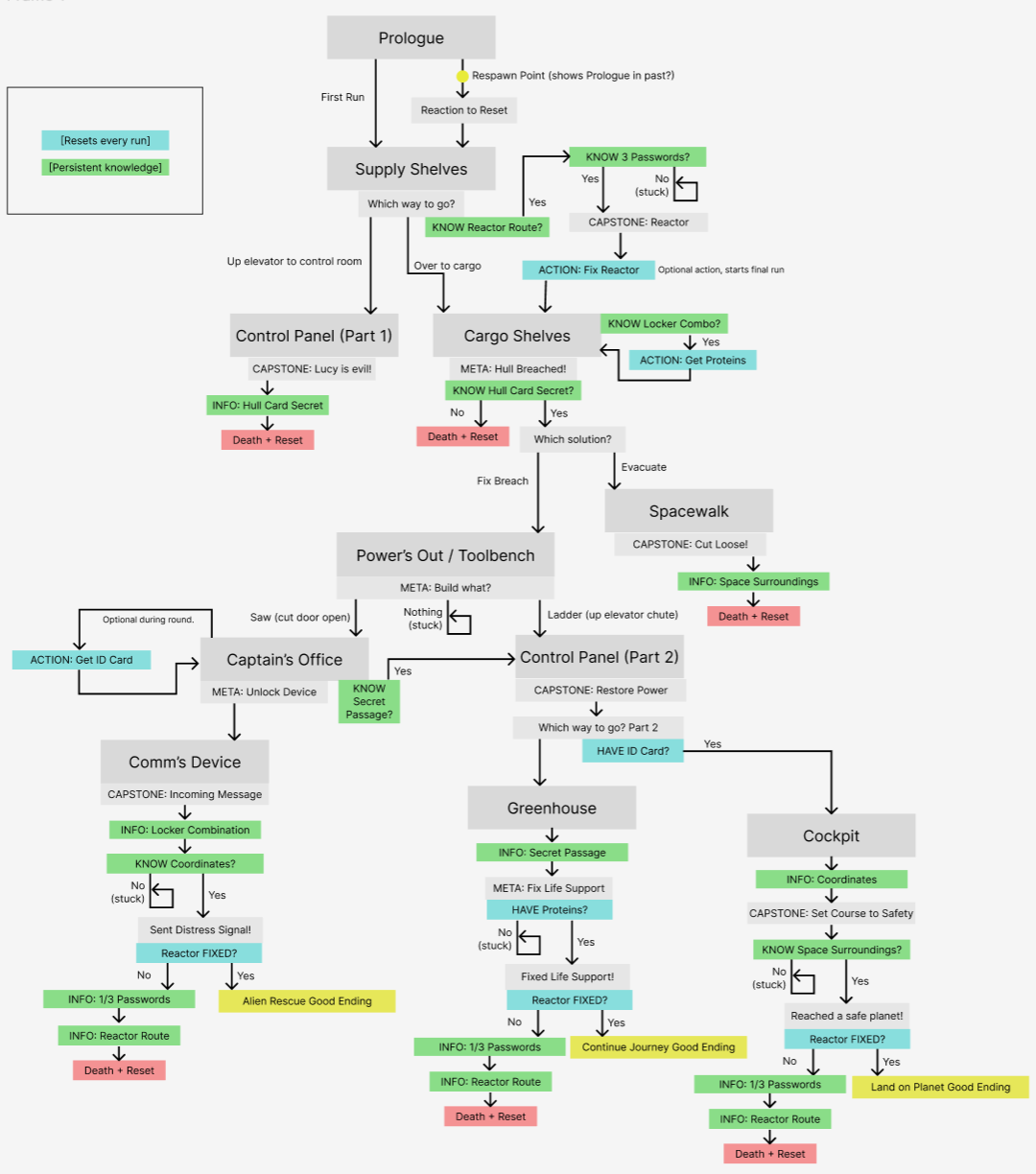
Story Integration Goals
We discussed several problems that hunts often have with story integration. The biggest problem was that engaging with the story is often separate from puzzle-solving, so solvers must choose between experiencing the story or continuing to solve the hunt. To accomplish our primary objective of providing a “puzzle experience” we made the following decisions:
- We want solvers to interact with the story in order to progress in the puzzles.
- We want the story to be relevant to puzzles, so you have to pay attention to it in order to solve at least some of the puzzles.
- We want the story to be compelling, enjoyable, and concise.
- We want individual puzzles (at least the capstone puzzles) to feel relevant to that part of the story - in particular, decisions solvers make in pivotal puzzles have a real story impact.
- We do not want a separate puzzles page and story page.
Some of these decisions were contentious, such as the choice to omit an “All Puzzles” page, a puzzlehunt standard. We tried to mitigate this with other design decisions to smooth out the experience, including a dropdown to access past timelines and the ability to view and check answers to puzzles regardless of timeline.
We think that we were broadly successful at all these goals! While it was a lot more design, writing, and structure work to get everything to fit together, we think that our close story integration resulted in a hunt that felt like more than the sum of its individual parts.
The Comic as a Narrative Engine
The comic style as the hunt presentation medium was not part of the original proposal, but was suggested soon after the theme was chosen. Art is one of our team’s strengths. The art team was excited to draw a comic, and we felt like an interactive choose-your-own-adventure puzzle-embedded comic would be a great way to accomplish our story goals. Puzzlehunt round art often resembles a static scene or a map, with puzzles placed in particular locations. The comic presentation let us attach puzzles to points in time instead, which is more analogous to how they fit into the hunt’s story.
We spent significant time deciding how to mesh puzzle solving with story progress. In a typical puzzlehunt, entering a correct answer into the answer checker immediately unlocks new puzzles and maybe some story progress. However, since solvers in this hunt would be navigating through the same part of the comic repeatedly, we realized we needed to provide a more convenient alternative to submitting answers on puzzle pages. Eventually, we decided that finding the answer to a puzzle and progressing in the story using that answer should be separate actions.
This presentation medium also solved the problem of multi-answer puzzles and how to handle multiple timelines:
- Solvers can input multiple answers to a puzzle on a puzzle page, and then select one to take as their “action” in the comic.
- Solvers don’t need to re-solve puzzles on a new timeline, since their answers have already been checked on the puzzle page.
Of course, breaking puzzlehunt tradition led to its own UX challenges. To address this, we needed to teach solvers how to submit “actions” on the comic, and added a tutorial branching point (Where to Next?) to teach solvers that decisions matter.
Writing Characters
Common story feedback we’ve heard from our last two hunts is that solvers enjoy our story beats and atmosphere, as well as character design.
Here’s an informal guide we used to copyedit our comic and characters:
- Strive to keep character voice consistent. Not every voice needs to be super distinctive and unique, but it’s important that your characters sound like themselves. Resist the urge to come up with a unique accent for every character and instead work to ensure the things they say sound like they came from the same person.
- Keep it short, stupid. In a gameplay-centric medium like a puzzlehunt, where puzzles, rather than dialogue, is the main attraction, it’s important to be concise so that solvers don’t feel like reading is the chore between puzzles. Similarly, in a visual medium like comics, keeping text brief lets the visuals shine and do a lot of heavy lifting in storytelling. This means that you use the text to do things that only text can do - and a lot of that is characterization.
- Don’t write what they won’t read. Backstory and setting details are cool, but only if the audience actually sees them. Focus on making what the audience does see sparkle - making your characters feel like real people is less about making it so you know every detail of who they are and more about making their reactions feel consistent and well-rounded.
- Give your characters rough edges, or at least have them push back against the text sometimes.This is a small but important part of the teammate character magic. Whenever there’s a convenient character trait to give someone to fit their archetype or story role, try to push back on it just a little bit. It can be something as small as having Sky be unfamiliar with the part of the planet they land on (spoilers if you didn’t pick Plot A Course!) or as large as having MATE be prickly and defensive with solvers, even when they’re supposed to be sympathetic. Tropey plots can be fun, but tropey characters usually feel lifeless.
Non-Puzzle Comic Interactions
We had several notions of how puzzles/story could influence each other in a branching structure:
- Info keys: You learn a piece of information on one timeline and can apply it on a different timeline. All of these are accessible from the beginning of the hunt (“hidden in plain sight!”). For example:
- Using the information from the playing cards (on the Control Panel timeline) to solve Hull Breach (on the Cargo Shelves timeline)
- Using the blueprints from the Greenhouse to go through the secret passage in the Captain’s Office
- Finding the reactor door is possible on run 1 if you know to Turn Around. To prevent lockout, we blocked the option to submit this answer in the comic on run 1, before teams discover the watches.
- Opening the reactor door (thereby fixing the reactor, which otherwise ruins each attempt at an ending) is possible early on if you knew enough about Captain Houston, Lucy, and Sky.
- Action keys: You have to take a particular action in the comic in order to be allowed to access other things. For example:
- Opening the safe is required to solve the Greenhouse meta.
- Picking up the ID card in the Captain’s Office is needed to unlock the Cockpit.
Hunt Endings
Here are the sets of panels that teams would see depending on which good ending they chose in their final run!
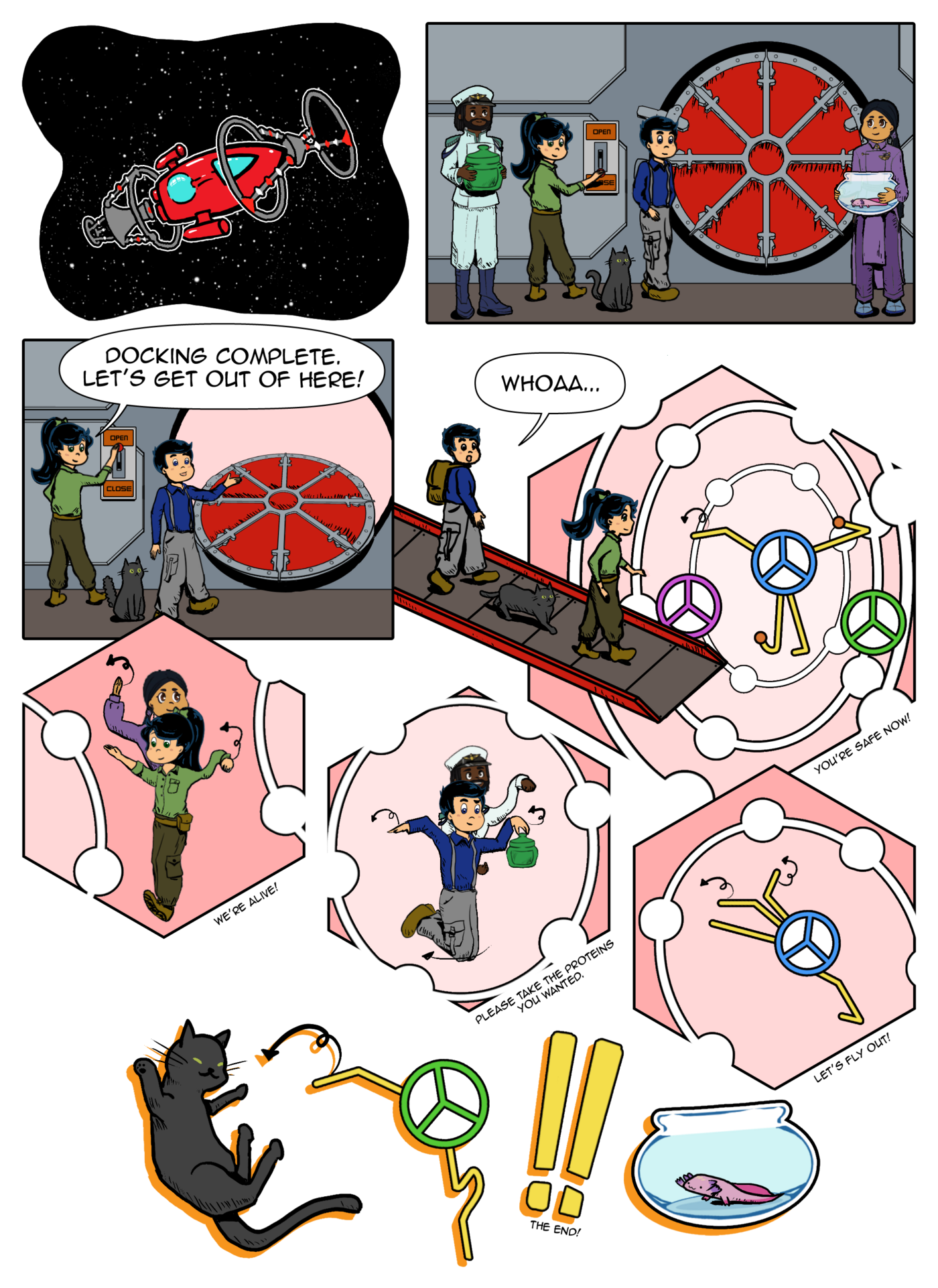 Captain's office (alien communication) good ending, storyboarded by Ariel, drawn and colored by Tracey
Captain's office (alien communication) good ending, storyboarded by Ariel, drawn and colored by Tracey
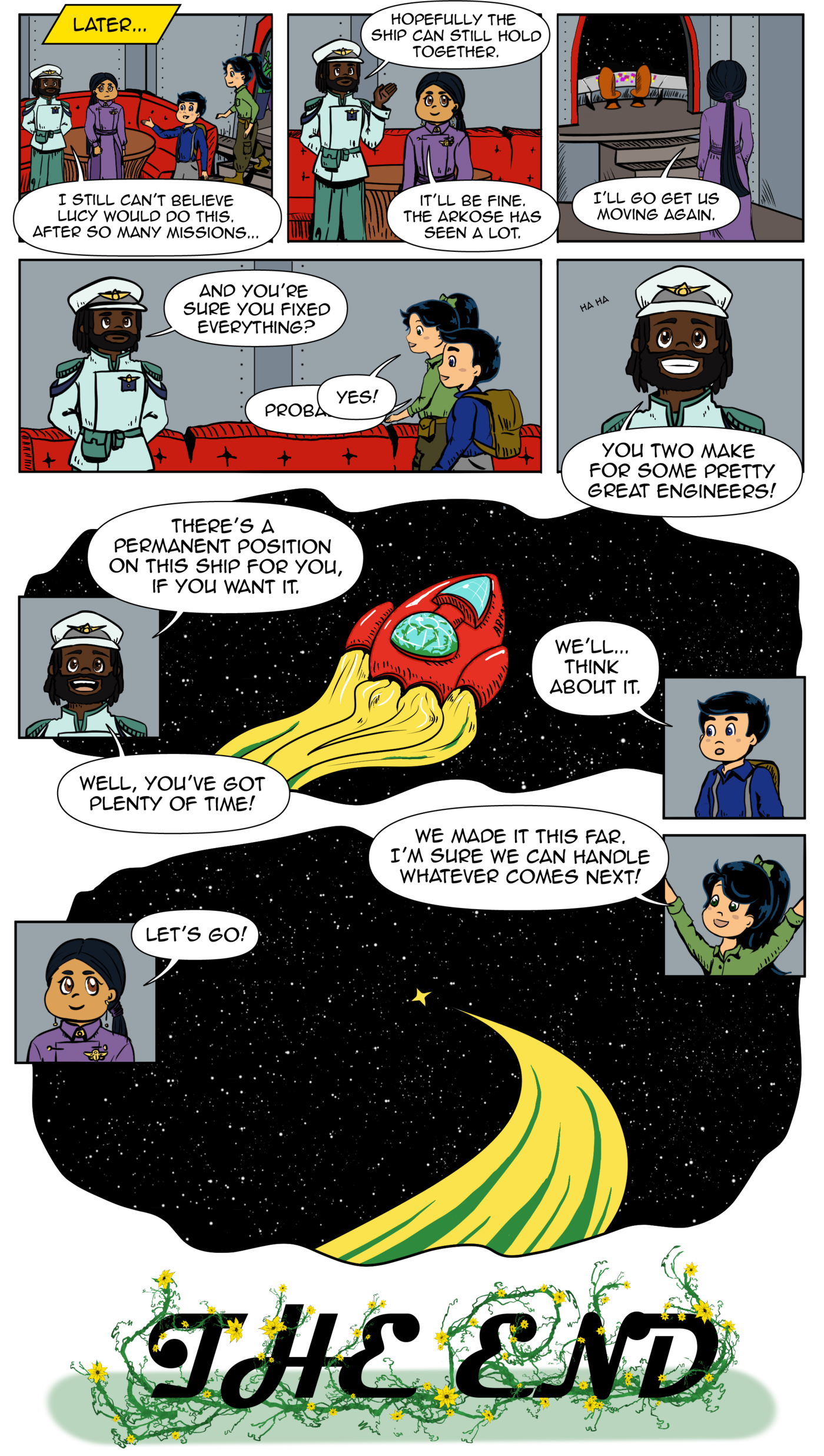 Greenhouse (fixing life support) good ending, storyboarded by Jacqui, drawn by Olga, and colored by Tracey
Greenhouse (fixing life support) good ending, storyboarded by Jacqui, drawn by Olga, and colored by Tracey
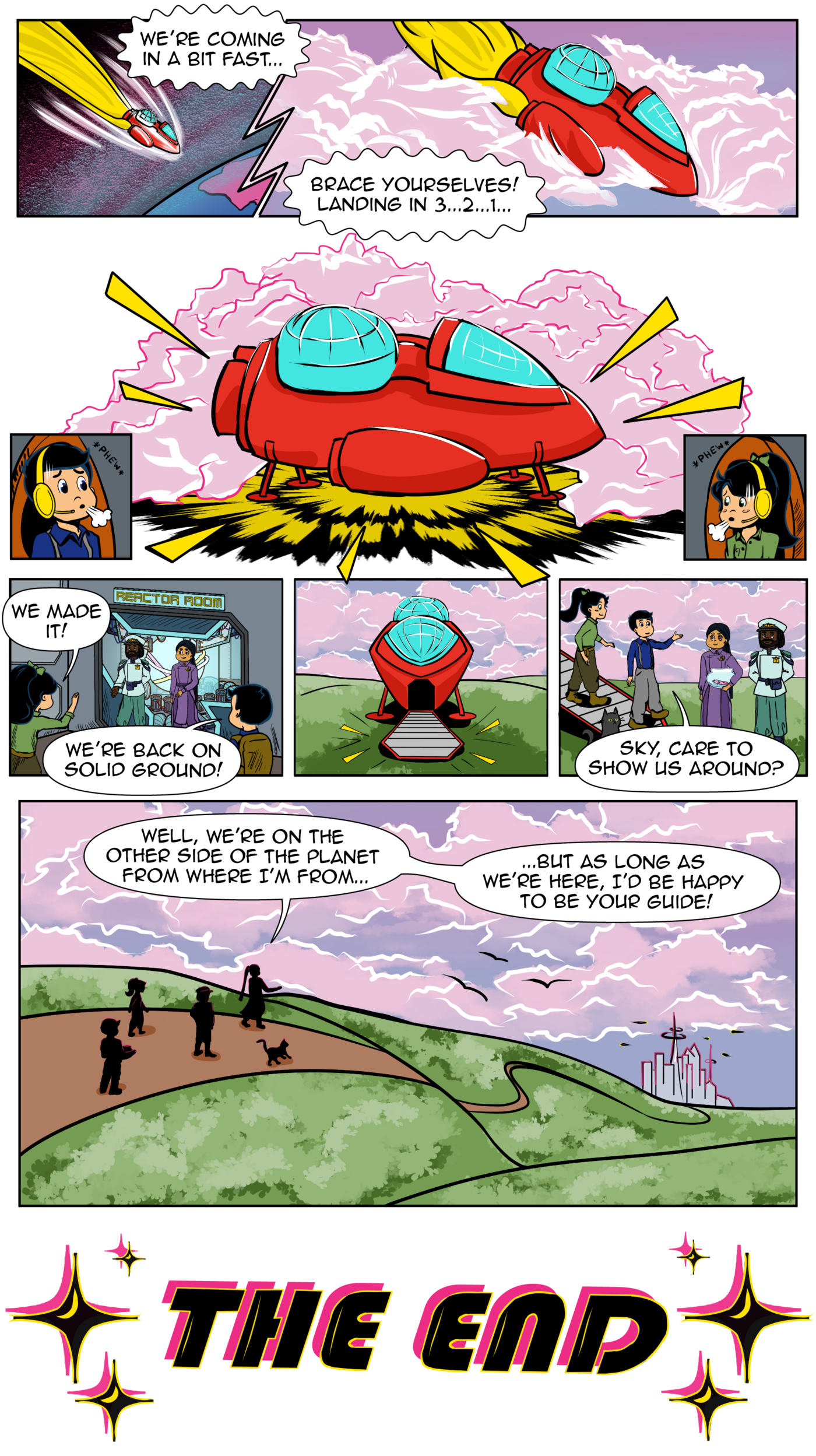 Navigation (plot a course to a safe planet) good ending, storyboarded by Cat, drawn and colored by Olga
Navigation (plot a course to a safe planet) good ending, storyboarded by Cat, drawn and colored by Olga
As many of you have wondered, it is in fact possible to die for real on the last run if a team makes a mistake after yeeting away the timeium watches. However, there is no achievement for this, as we didn't want to encourage it.
- 1 team tried to fix the Hull Breach with a hammer
- 4 teams tried Spacewalking and drifted away into space
- 4 teams went to the Greenhouse but forgot to bring the proteins and ran out of oxygen, receiving the below panel:
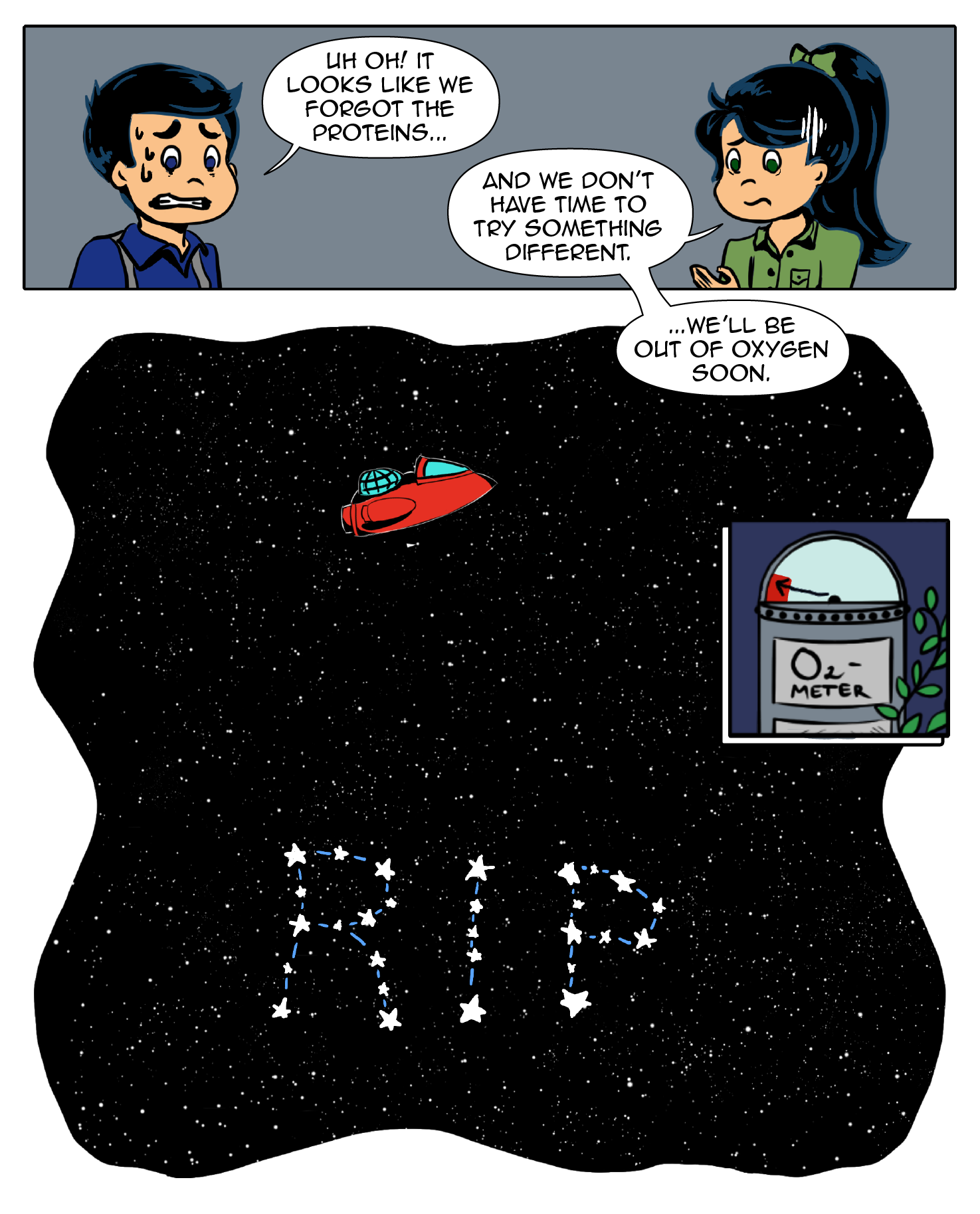
HQ planned for this situation, and we manually restored runs to allow teams to finish for real, if they wanted.
Team reactions to this were anywhere between apologetic at the incident:
- we thought we might get an achievement for dying permanently. do you think you could have pity on us and let us choose a real ending?
- We finished The Reactor and wanted to drive the Arkose to the Marsh Haven but took a wrong turn and we don't have our watch anymore :O Do you have timeium to help us reset this? Oopsies.
To somewhat confused:
- Hi we died :)We fixed the reactor, and went the greenhouse route without taking the proteins, and died horribly without our watch. Is this the end of the hunt or can we yet be saved?(not a hint request, just legitimately unsure~~~)
To angry:
- So that's it? I forgot the proteins and now I'm completely locked out of completing the hunt? I know it said to be careful but it's still a bit of a sting. As a team of one it's been really hard to remember everything. Well regardless, other than my ending I have very much enjoyed the hunt.
To blatantly shameless:
- Can you unkill Matt and Emma for us? We still stand by our decision, but we would like to finish the hunt.
Our reply in each case:
Well, [TEAMNAME], you went and did it. You just had to mess around with things after you got rid of the time-travel watches. Now Matt and Emma are going to be floating in the void of space, forever. What did you think was going to happen?
Well, nothing you can do now but think about your actions.
Unless somehow the team running the hunt could magically undo your terrible mistake…
All right, fine, your final run is going to become a little bit less final as we scramble to fix the timeline you destroyed. Please don't do it again.
-teammate
Each of 9 teams that we reset went back to complete the hunt successfully and see a good ending - but we shame them here for killing Matt and Emma after all the twins have been through this hunt.
- Defying Grality
- Meticulous Choreographer of Celestial Bodies
- Needlessly Eating Sednas
- Pusheen Appreciation Society
- Team to be named at a later date
- The_Underscore_Crew
- URLy Onset Stupidity
- Vorpal Swords
- 🌮🌮taquito
Writing Philosophy: Nontraditional Puzzle Formats
teammate has historically been interested in breaking out of the “Each puzzle has one answer which is an alphabetical string with no whitespace” mold.
Answerless Puzzles: As a solver, a common experience is solving a great puzzle and being stuck on (an often unrelated) extraction for hours. As a puzzle writer, a common experience is struggling to make your great idea extract to some random answer. These were the main motivations for including so many answerless puzzles. Sometimes, the extraction isn’t fun and is just an add-on to a puzzle to get it to work with a meta.
Multi-Answer Puzzles: The main motivation here was to provide a mechanic for “choosing your own adventure” via puzzles. It was a fun challenge for authors to figure out how to write puzzles with obvious multiple answers (e.g. feeder puzzles in Tool Bench), or to write puzzles with hidden extra answers (e.g. Hull Breach), or to write interactive puzzles with both (e.g Where to/2 Next).
We wanted to leave freedom in this hunt for authors to write both traditional puzzles (extract to a single answer) and nontraditional puzzles (interactive, answerless, multi-answer, etc).
We had a bit of trouble wording our About page to make sure that we didn’t make any claims that each puzzle has exactly 1 answer, or even that puzzles have an answer at all. 😛
Capstone Puzzles, Innovative Rounds and Sequences
We were very interested in breaking away from traditional metapuzzles and traditional round structures. We define a “capstone” puzzle as a puzzle that culminates a round, but does not necessarily use feeder answers as input. We wanted capstone puzzles to always be relevant to the plot both in theming and mechanic. We had various types of capstones:
- “Traditional” metapuzzles (Under Control, Hull Breach, Built to Spec, Botany, Unlocking the Comms Device) - these used their feeder answers.
- Nontraditional metapuzzles (Plot a Course) - this used the feeder solutions, but they weren’t answer strings.
- Combinations of round mechanics (Back in Control, Asteroid Alert, The Transmission) - The capstones made use of putting together the previous mechanics learned in the feeder puzzles, though Asteroid Alert technically uses answers too.
- Thematic only (The Reactor) - We didn’t want to overconstrain the ending capstones by writing a metameta. We used the locks on the door to tie in the 3 main rounds of the hunt, and then the reactor capstone itself was fully centered around the story/plot.
We also wanted to explore the concept of “sequences” - multiple puzzles that are related, and build up additional complexity/difficulty as you progress in the sequence. We thought GPH 2024 and Jack Lance’s P.I. Hunt 8 did an excellent job with this idea. We had the idea to include sequences before doing GPH, but were inspired to pursue it further due to GPH’s success with it. We had 2 fully sequenced rounds:
- Spacewalk: We designed this round with two goals in mind: 1) Make cryptics more accessible to new solvers, and 2) Invent and build upon new mechanics that have never been seen before. See the Authors’ Notes for more details!
- Navigation: This round was foremost designed around the story of Matt and Emma plotting a course to a safe planet, and the meta mechanic of a three-dimensional maze. Early on in ideation we were exploring making this an unconventional round, and sequences was a popular method. Since there was interest in exploring both word (Strands) and logic (minesweeper, nonogram) mechanics, the round was divided into three parallel tracks similar to the Spacewalk round.
We also had 2 rounds which we tried to build with similar concepts:
- Control Panel: Given our time-travel plot, we were interested in designing a round set in the same location in alternate timelines. The first time Matt and Emma go to the Control Panel is pre-Hull Breach when Lucy is still on board. The second time is after the power’s gone out and Lucy has escaped. We had two versions of each puzzle, an easier first version at beginner-level difficulty and a harder second version with an additional twist. This structure was the only constraint given to puzzle authors; otherwise they were allowed to choose their own answers. Both capstones (Under Control and Back in Control) were written after the puzzles were constructed.
- Captain’s Office: We wanted to build up knowledge of the conlang throughout the round. Interpreting the conlang would be part of solving the individual puzzles, and not just something to go back to at the end for the meta.
Here are some notes on constructing our multi-answer metas:
- Hull Breach: This puzzle took way longer to write than we originally expected. We had foolishly set ourselves the unenviable task of writing a metapuzzle which needed to be both fairly easy and approachable, and also have two different answers which used the same answer set and shell, and also have one answer be slightly harder to get than the other so it could be clued by a story element, while also having a third dummy answer for the initial reset. We played around with a lot of different versions of this (at one point involving Mahjong tiles) or cluing specific Rider-Waite tarot cards, before drastically simplifying to the version we have here.
- Built to Spec: We felt that having a round full of small decisions and branching points would be a great way to take advantage of our hunt’s mechanic. We considered several possible structures, but landed on having two parallel decision trees and using every feeder puzzle in a valid meta answer (although not every answer would be used).
Lastly, Where to Next and Where 2 Next: Electric Boogaloo were designed as direct sequel puzzles. We had many more ideas for other mechanics that had to be cut to reduce scope.
Solver Experience
We had two main goals:
- Capture the fun “ahas” without sacrificing on solver experience. No excessive grunt work, random indexing of columns, or getting stuck on final extraction.
- Make the hunt accessible to casual puzzle gamers and not just long-time, top 10 leaderboard puzzlehunt teams.
Here’s how we aimed to accomplish this:
- Write “easier” puzzles in the Gear Up, Control Panel (part 1), and Tool Bench rounds. All puzzles in these rounds were edited heavily for difficulty and length.
- Audit all of the intro puzzles for accessibility to beginner solvers. We also tried to tune things even in the later puzzles of the hunt, but weren’t as strict. We specifically wanted to avoid:
- Puzzle-ese / conventions only known by experienced solvers
- Esoteric knowledge (e.g. college-level math, extremely specific references)
- Getting stuck on having no idea where to start (mitigated by adding extra flavortext, tutorial elements, or rocket boosters)
- Getting stuck on extraction (we kept most extractions very straightforward and tried to clue the extractions when possible, or removed extraction steps entirely for answerless puzzles).
- Add “rocket boosters” and enact a very permissive hint policy and encourage its usage (in part enabled by the non-competitive aspect of the hunt).
- Add a Help Desk page with a Contact HQ form intended for story-related hints.
- Ensure that all puzzles, aside from capstone puzzles (and special puzzles like Where to Next?), are skippable - you can solve the capstone without them.
- Run an “intro round” testsolve with less experienced testsolvers, specifically to tune our intro rounds for accessibility.
Did we accomplish these goals? We think so! Here are stats comparing this hunt with previous teammate hunts:
| This Hunt (2025) | 2021 | 2020 | |
|---|---|---|---|
| Teams registered | 763 | 493 | 536 |
| Teams who solved >=1 puzzle | 603 | 384 | 416 |
| Teams who solved >= 10 puzzles | 455 / 603 (75%) | 261 / 384 (68%) | 235 / 416 (56%) |
| Teams who finished | 147 / 603 (24%) | 67 / 384 (17%) | 61 / 416 (15%) |
| Teams who finished on the first weekend | 24 | 10 | 7 |
| Hints answered | 10773 | 3556 | 2601 |
Notably, a higher percentage of teams were able to progress past the intro rounds, and a higher percentage were also able to finish the hunt.
We did still want to include some harder puzzles and make sure that experienced teams have a great time, too. After the Tool Bench round, the puzzle difficulty increases substantially.
Some Downsides and Words of Warning
We believe our puzzle/story co-design and focus on solver experience led to an extremely cool hunt! However, it is one reason that our hunt writing process lasted over a year (far longer than was originally planned).
The time travel and cross-timeline interactions were big contributors to the complexity. The branching structure in its constantly developing, unpolished form was hard for both authors and editors to keep track of when deciding how to focus writing efforts. This led to increased amounts of back-and-forth required to create a tight integration. Often, making decisions on one part of the hunt was blocked on progress in other parts of the hunt.
Another downside of our design approach was that associating puzzle solves with story progress meant that we had to create more bottleneck puzzles than is typical for a hunt. At these points, teams might have only one unsolved puzzle gating their progress, usually a capstone. This meant there was a lot of editorial pressure to smooth out structural pinch points. Common concerns that came up in discussion were that our puzzle radius is too low and teams could get stuck easily.
Our actions to improve solver experience were largely successful, as we show by our engagement stats above! But this came at the expense of our workload both before and during the hunt. During the hunt we answered about 200% more hint requests compared to during Teammate Hunt 2021, leading to longer wait times for responses, especially during US nighttime hours. We also had a large overhead load to resolve submissions for Make Your Own Metapuzzle and The Transmission. Although our tech setup streamlined the internal grading process, the volume of submissions was significant.
Timeline
We began work on the hunt in mid-February of 2024, with the intention to release during fall of 2024. The hunt was ultimately run in late March 2025. (Alas, our internal codebase still refers to the hunt as “tph-2024”.)
Our real timeline:
- Mid February 2024: Hunt goals finalized
- Early March 2024: Theme selected, meta brainstorming begins
- Mid April 2024: Internal puzzle potluck 1 held
- Mid June 2024: Internal puzzle potluck 2 held
- Late June 2024: Some feeder puzzle answers released
- Early January 2025: 65% of the planned puzzles “written”
- End January 2025: Hunt announced, splash site released
- Mid February 2025: Registration opened
- Mid/late February 2025: Intro rounds testsolve, up to Hull Breach
- Early/Mid March 2025: Full hunt testsolve (with a mostly uncolored comic)
- Mid March 2025: Last capstone and its feeders finalized (Navigation)
- March 28, 2025: Hunt launch
- March 28, 2025 (5 hours into hunt): Last comic panel art submitted
Art
A Newbie Perspective on How to Draw a Comic
When the comic idea was floated, we knew it was the right presentation medium for the hunt. Despite it being a large task, the art team was quite excited by the prospect of a fully visual integration of puzzles and story. Most of the artists on the team have worked together during Mystery Hunt 2023 or Teammate Hunt 2021, so we were confident that we could split the work up and still achieve a consistent design.
Unfortunately, none of us knew the first thing about drawing a comic. The requirement to embed puzzle content further complicated the process, compared to a workflow for drawing a comic with a linear story.
Comic Development Process and Timeline
Each section of the comic was done in several steps, often by different people:
- Storyboarding: Referencing a story master doc, we did a rough draft of the panel layouts, what each panel of the comic would look like, where the characters are, etc. These were done as simple sketches. Storyboards went through a “story review” by our main story team (Jacqui and Liam). The goal was to do most of the iteration in the Storyboard phase to minimize work during the Line Art phase.
- Character Design: Creating consistent character designs to be used as a reference in all the line art.
- Line Art: Actually drawing everything. This step was the majority of the work!
- Coloring: Adding color, shading, and texture fills to all of the line art.
- Lettering: The dialogue bubbles and text boxes were added in a separate layer on top of the rest of the art. This way the art and the dialogue could be iterated on in parallel.
Iterations at every step were done in order 1) to smooth out branching points where solvers' decisions affect the story, 2) to avoid red herrings in the art while making it clear when puzzle content is embedded, and 3) to make the art consistent with the ship layout.
Moodboarding
We started with some moodboarding last summer. For the setting and characters, we decided to go with a rustic, analogue aesthetic, with the ship feeling piecemeal and the characters dressed in baggy work clothes. This was inspired by media like Outer Wilds and Firefly, as well as a desire from our art team to avoid repeating the Puzzle Factory’s look from MH 2023.
For art style, we settled on a retro comic/cartoon style, modeled partly on Roy Lichtenstein line art and Ben Day dots. Our logo was designed with this in mind in preparation for releasing the splash site.
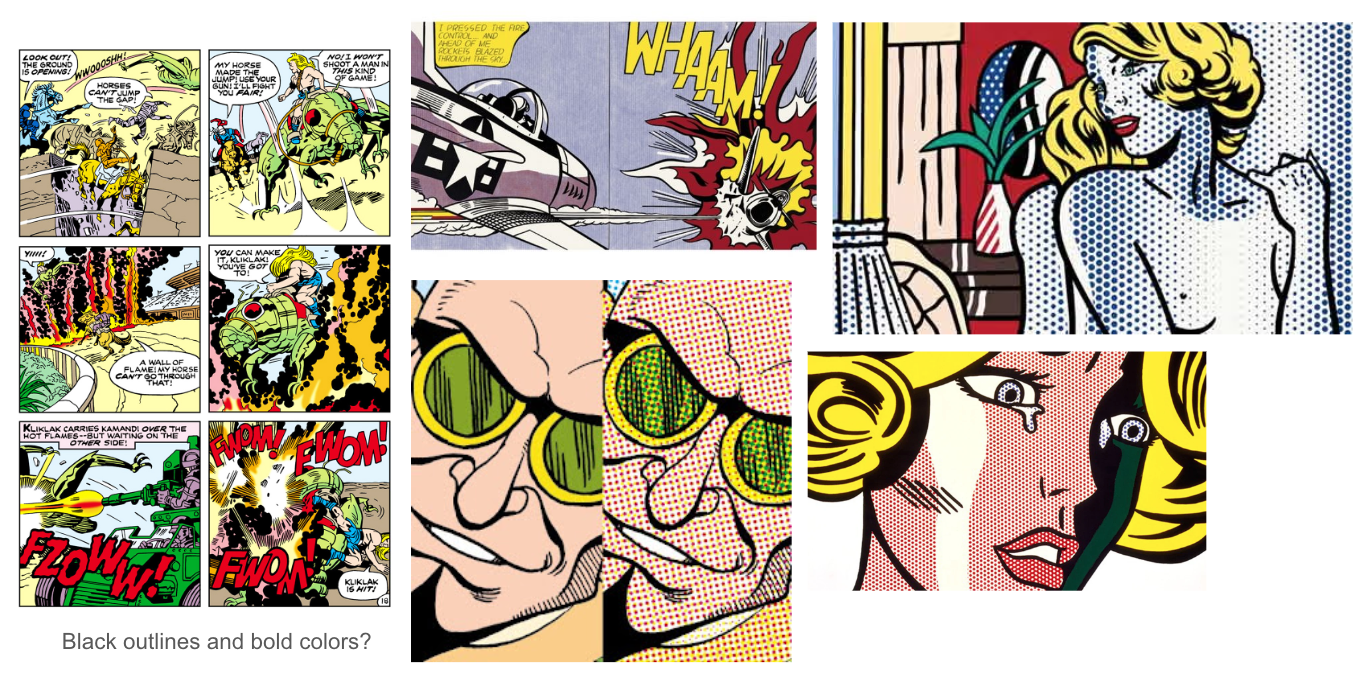
First moodboarding from June 2024
However, as preliminary line art and coloring tests were run and the comic cover put together in mid-February, it became clear that we were leaning away from strictly following this style. Not only was it mechanically challenging to standardize Ben Day dots, halftone filters, block shading, and hatched shading consistently for all artists, these elements together looked too haphazard to extend to the rest of the comic. Likewise, we wanted to use a larger color palette rather than what the Lichtenstein style assumed.
We revisited moodboarding after doing a deep dive into old school comic book coloring.

Second moodboarding from early February 2025
For simplicity and to decrease iteration time, we decided to avoid halftone textures or dot shading that we had in the comic cover. Halftone filters often introduce Moiré patterns which can be jarring when viewed digitally, so we decided it wasn’t worth the effort to figure out how to prevent those consistently. We opted for a more cartoon-ish style than traditional comic books, with simple block and hatched shading similar to Carnival Conundrum icon art. This turned out to be the right call, since our team was more comfortable producing this style en masse, especially as we got closer to hunt week.
We think we still ended up with a solid nod to the retro comic style, while adapting it to Matt and Emma’s latest adventure and creating a unique atmosphere for this hunt!
Prototyping
In concert with the story and puzzle editing teams, we created a functional prototype in Figma to test the experience of navigating the hunt structure around May of last year. We drew a lot of low effort dummy panels with stick figures for this prototype, and used buttons in the comic as a proxy for puzzle solves (which was adapted into our final UI). Only once we were certain that the comic could support our central hunt mechanic did we begin real storyboarding.

Ship Design
In order to maintain some level of continuity throughout the comic, we wanted to determine a consistent floor plan for the Arkose. Its layout was mostly motivated by the hunt’s structure, which determined the connectivity of different spaces. Starting with this connectivity graph, we held a collaborative mapping meeting in early July where we drew out a rough map of the ship’s two floors. Then, with some idea of where the ship’s key features would be (like the door, the cockpit, and the greenhouse dome), Cat made some sketches of the Arkose exterior and Jacqui polished the maps with that shape in mind.
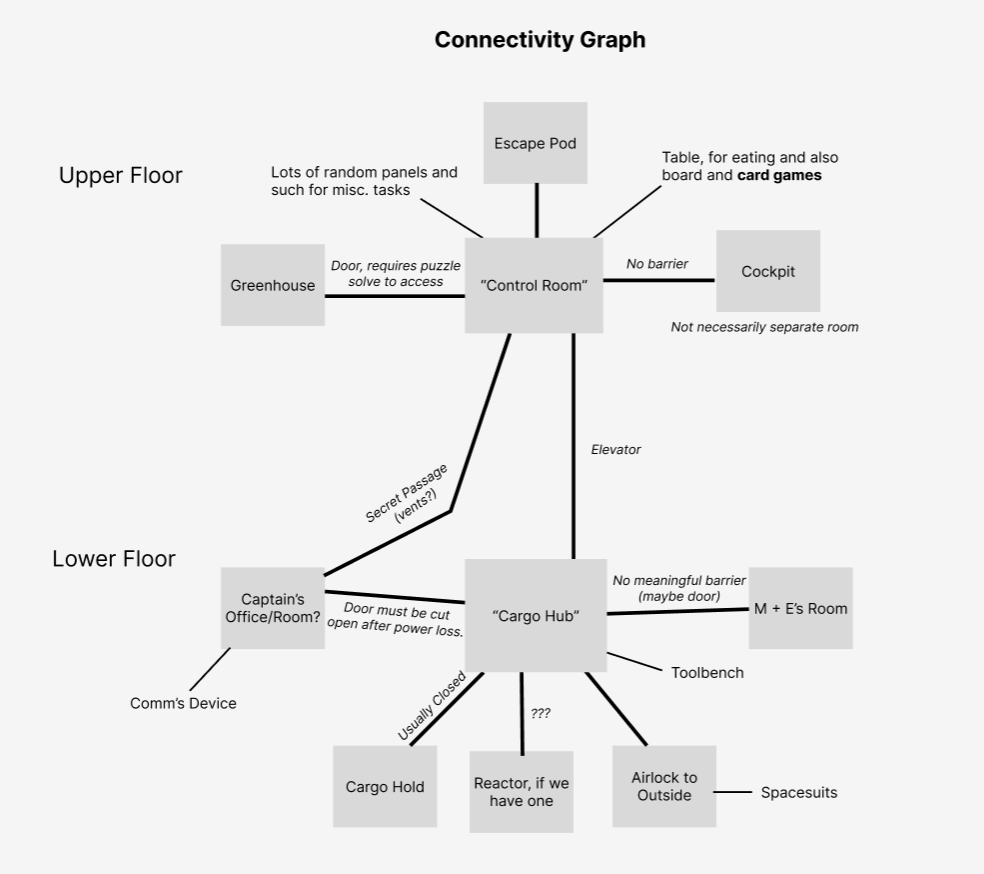
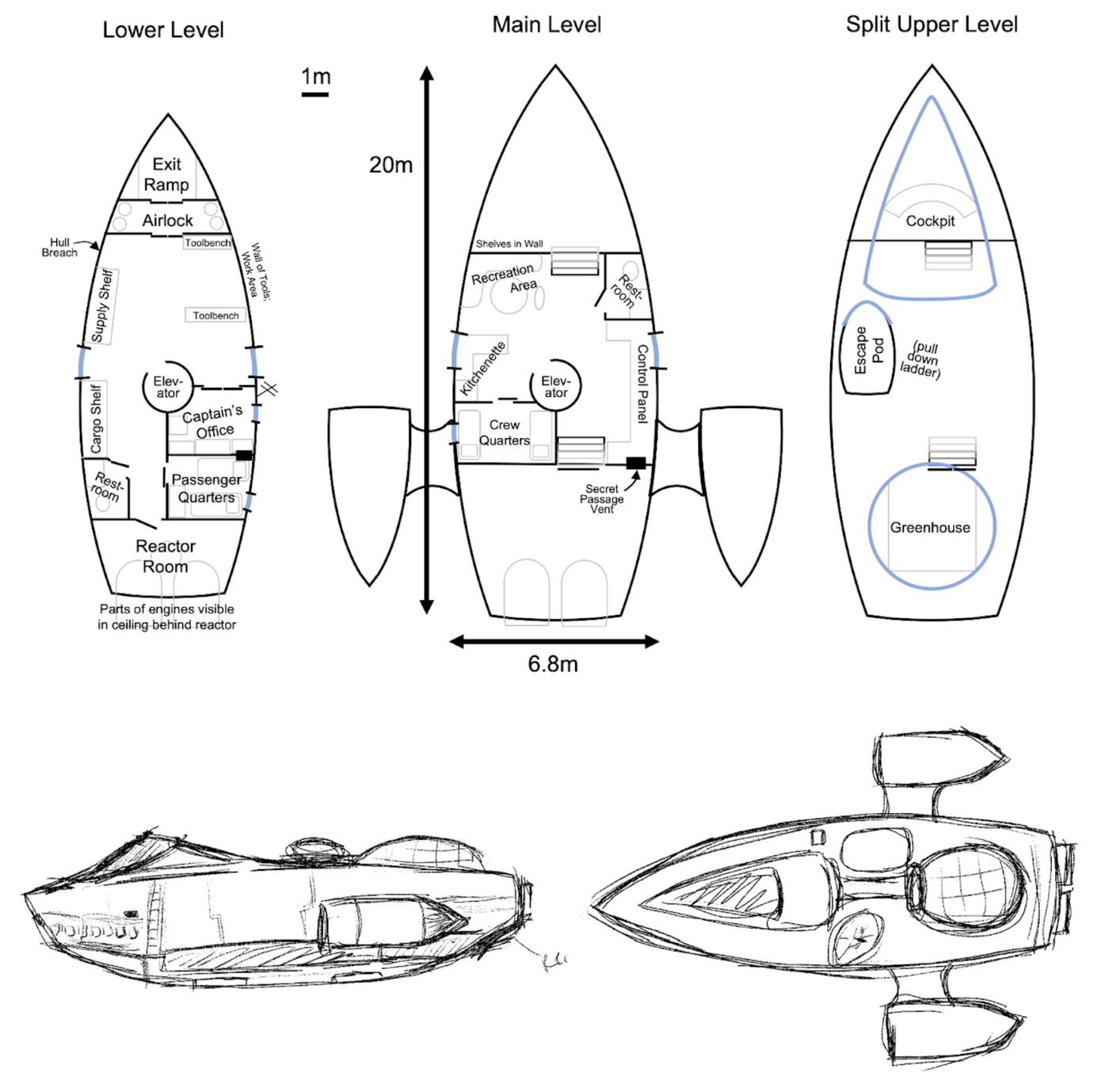
Character Art
In past teammate hunts, we’ve purposefully avoided introducing distinct character designs for Matt and Emma, beyond broad strokes like assigning each twin a color and making Emma have a ponytail. This was done 1) to save work effort, 2) because our artists generally don’t like doing human character art, and 3) to leave ourselves flexibility in the future for when it might matter more (and hope we gain more art capabilities by that point).
When the comic plan was chosen, the future suddenly became now, though our desire to do character art stayed about the same. Thankfully, some newer teammates are more versed in character art and were able to provide concept art from minimal descriptions.
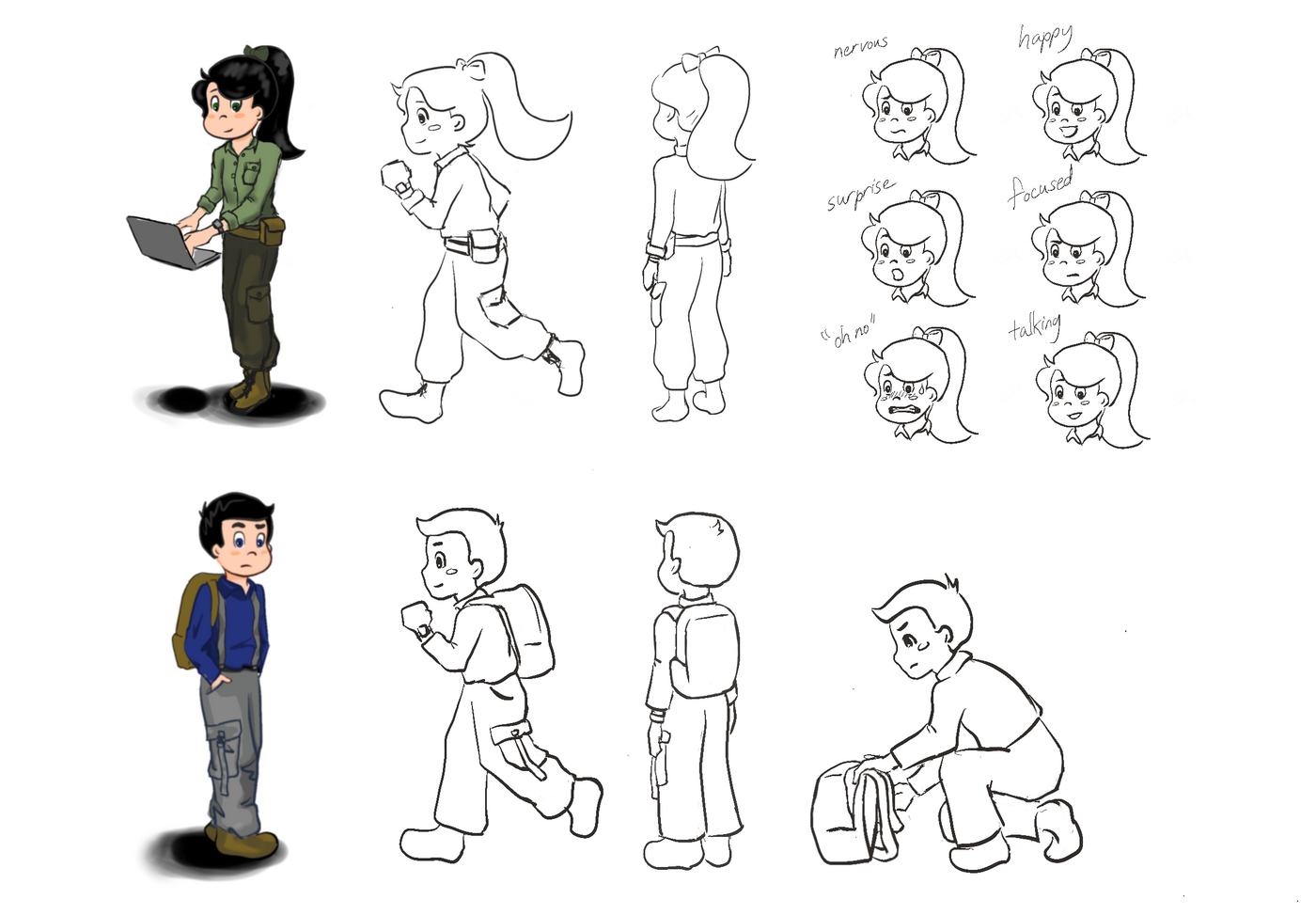
Emma and Matt, by Xiaolu
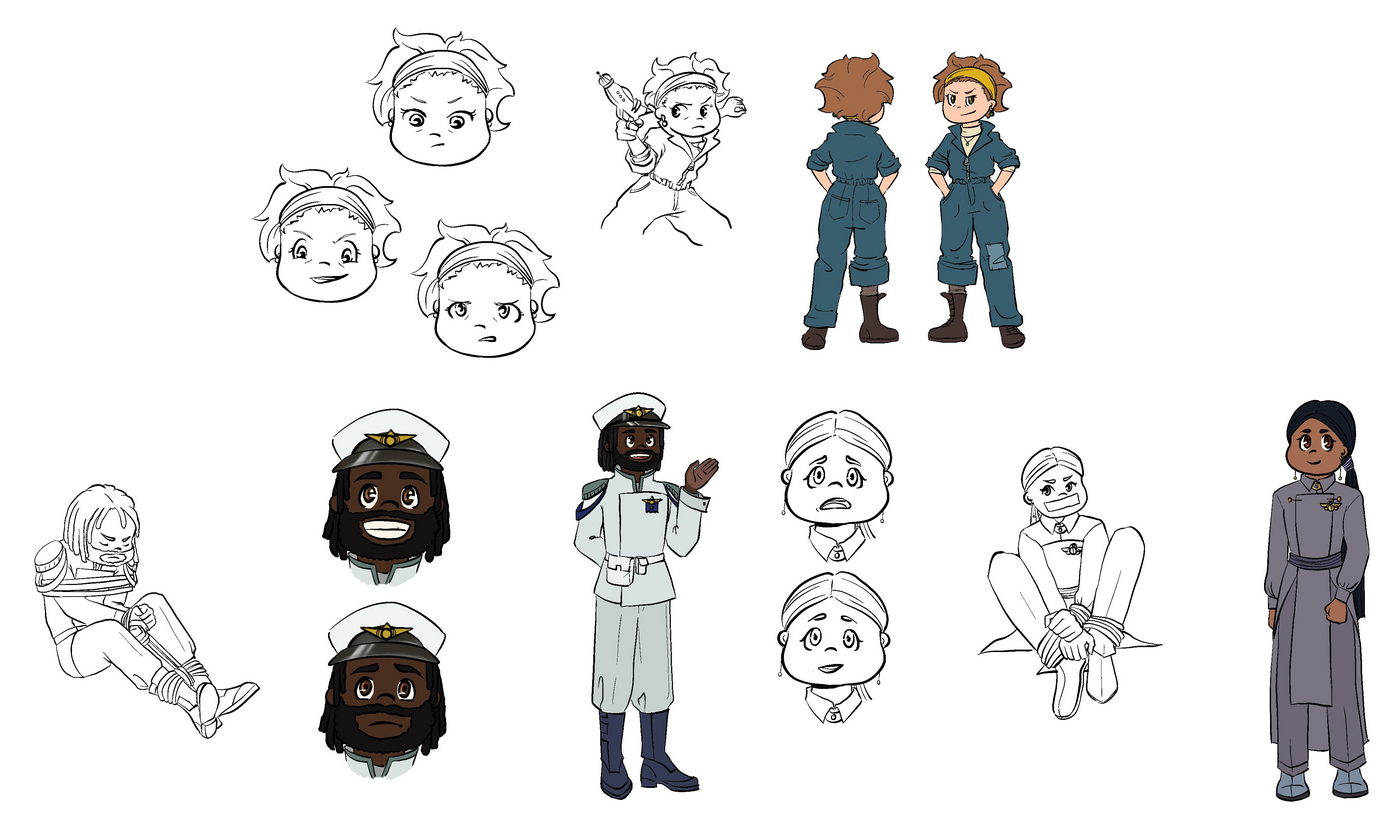
Lucy, Captain Houston, and Sky, by Audrey
However, drawing human proportions was still hard for the rest of us. We initially planned for character artists to add in the characters after each line art panel was done. Yet as the storyboards developed, it was clear this workload would be infeasible for the character artists, and we need to minimize the number of handoffs between steps.
So after the final character designs were shared in late January, Olga took a few days to study cartoon body proportions, coming back with an expanded pose sheet that line artists adapted to the rest of the comic.
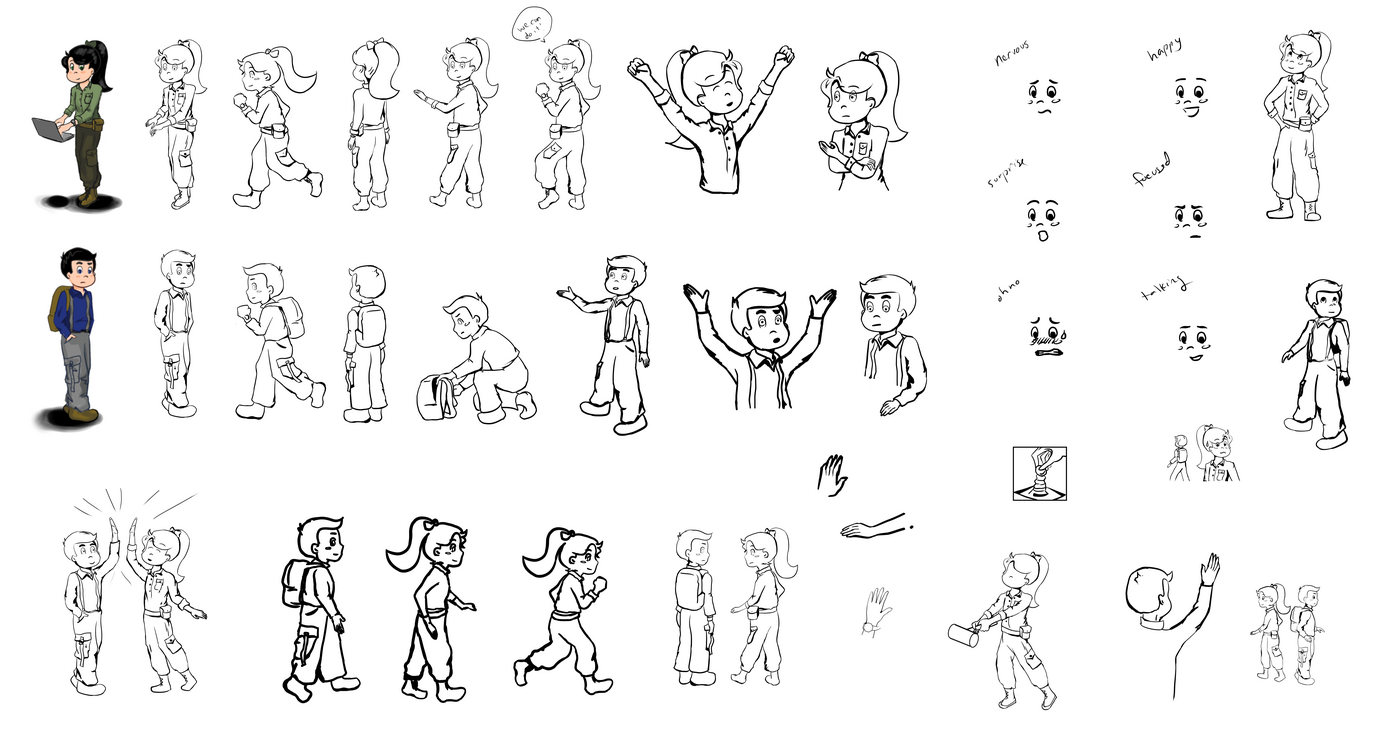
Expanded reference sheet for Matt and Emma poses, by Olga
Storyboarding
At this step we tried to plan our panel arrangements to capture all the story beats, leave room for future embedded puzzle content, and assess the length of the comic. We wanted to avoid forcing solvers to scroll through excessive vertical lengths of exposition. Each panel should be important in some way, whether it contains puzzle icons, story beats, info in dialogue, or action.
We had four artists drawing storyboards using a variety of paper and digital media.
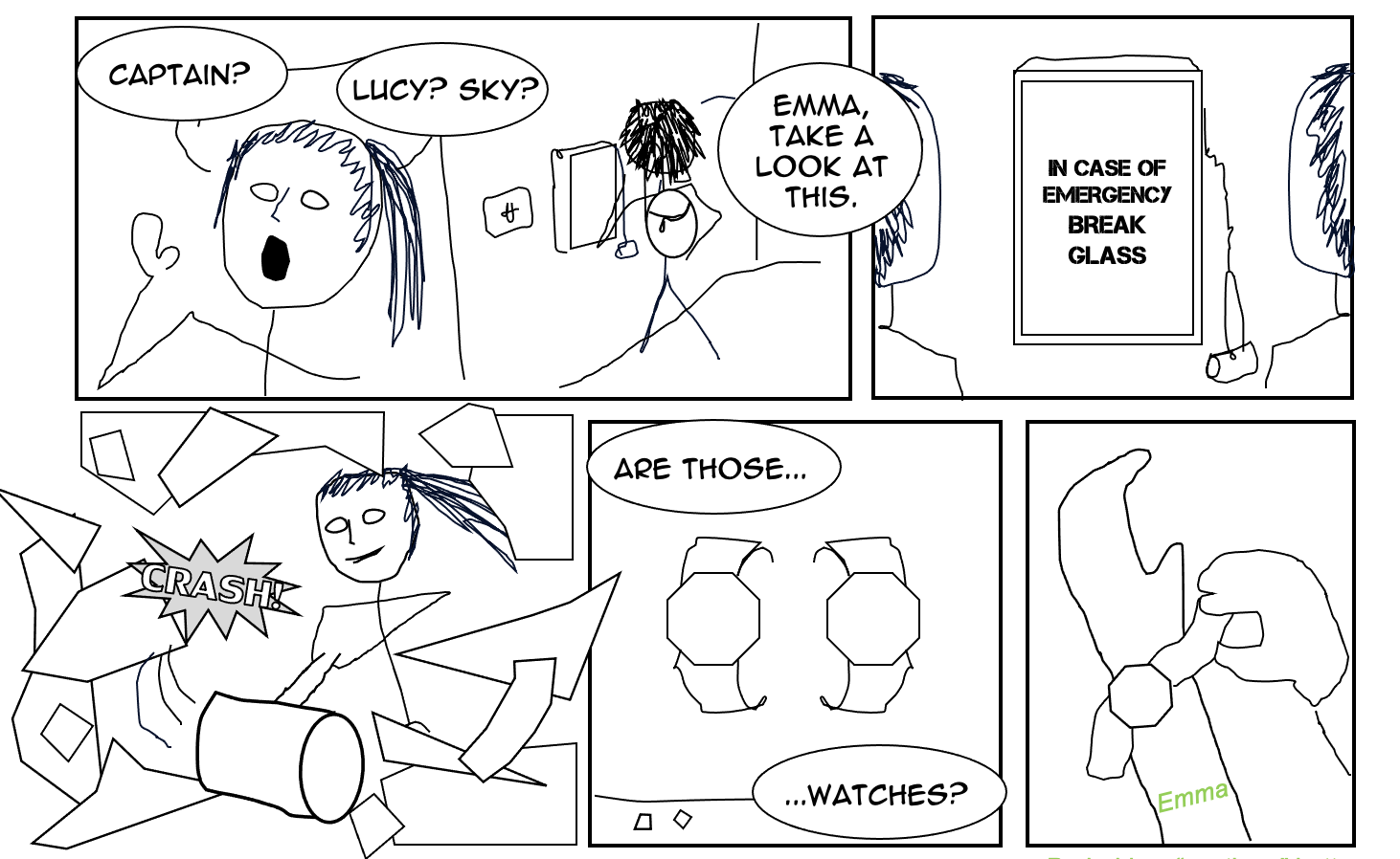
An example series of panels from the Prologue storyboard, by Jacqui
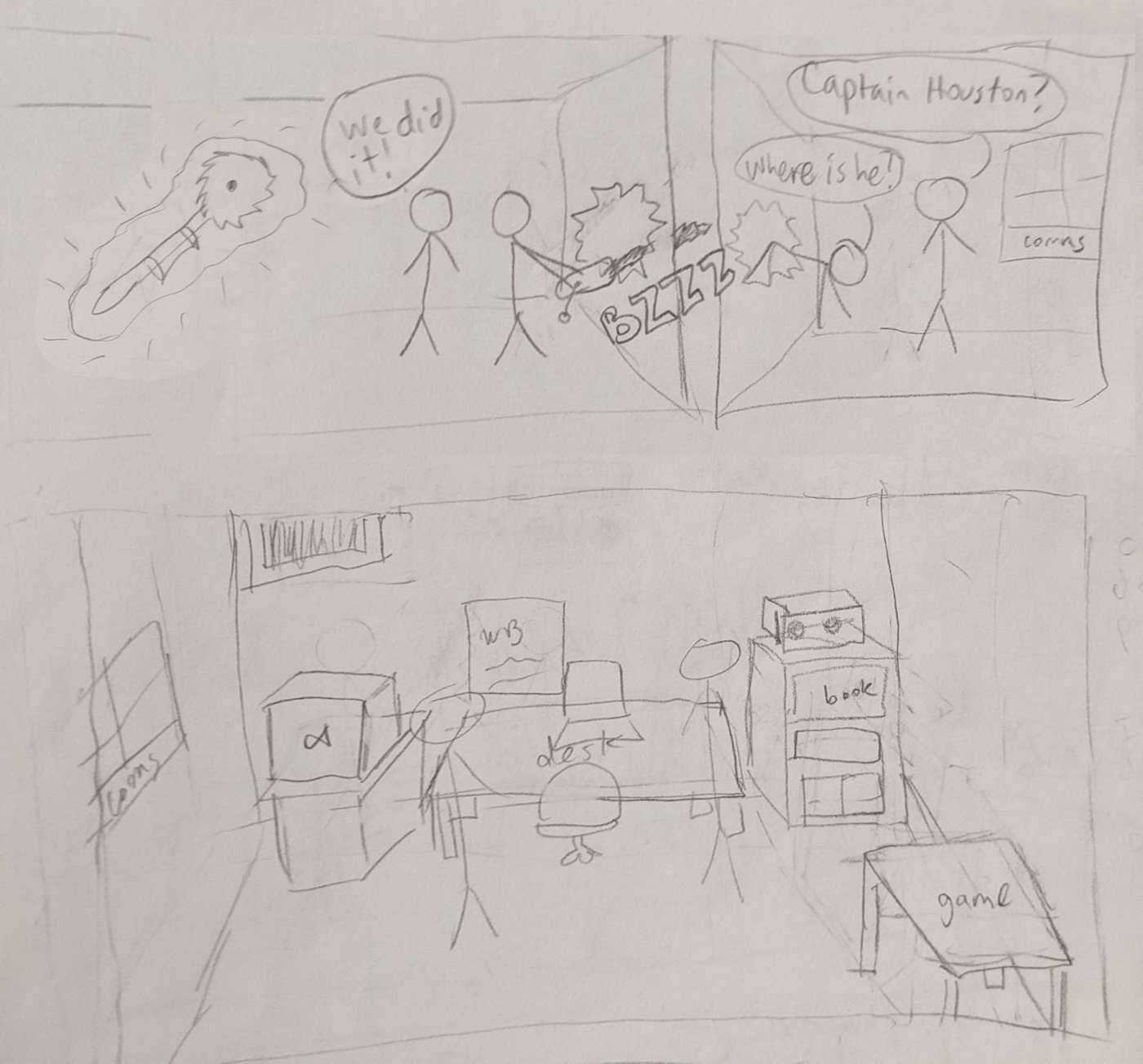
An example series of panels from the Captain’s Office storyboard, by Ariel
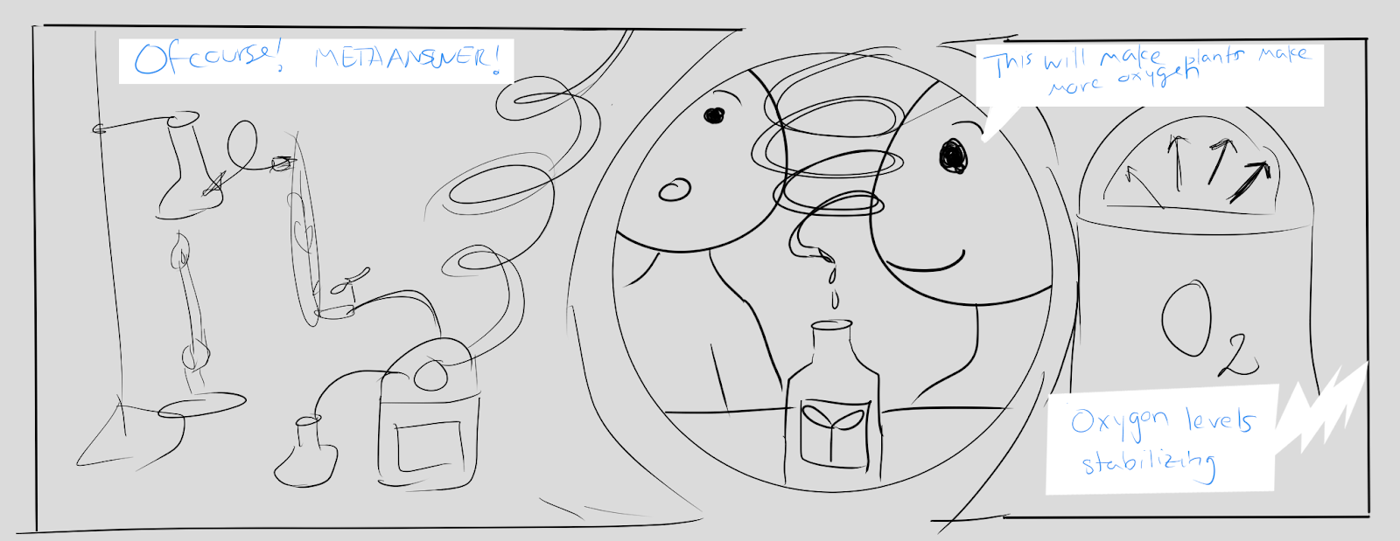
An example panel showing Matt and Emma finding the answer to Botany, by Olga
Line Art + Coloring
We did tests of line art and coloring using wide-angle environment panels such as the greenhouse and the captain's office, where characters are not the main focus. Line artists used these first panels to define standards like line thickness, panel dimensions, and general level of background detail.
We initially intended to split the work for line art evenly across four artists. As availabilities changed due to hunt or personal needs, we were running behind on getting all the line art done by our fullhunt testsolve. As a result, one artist (then conveniently unemployed) took over the rest of the incomplete sections. By the testsolve weekend in early March nearly all line art was done, some rounds were starting to gain color, and most of the final dialogue was updated during the testsolve itself. The rest of the coloring was done by five artists in the three weeks before the hunt, with the final panel (for a good ending) being submitted five hours after the hunt started.
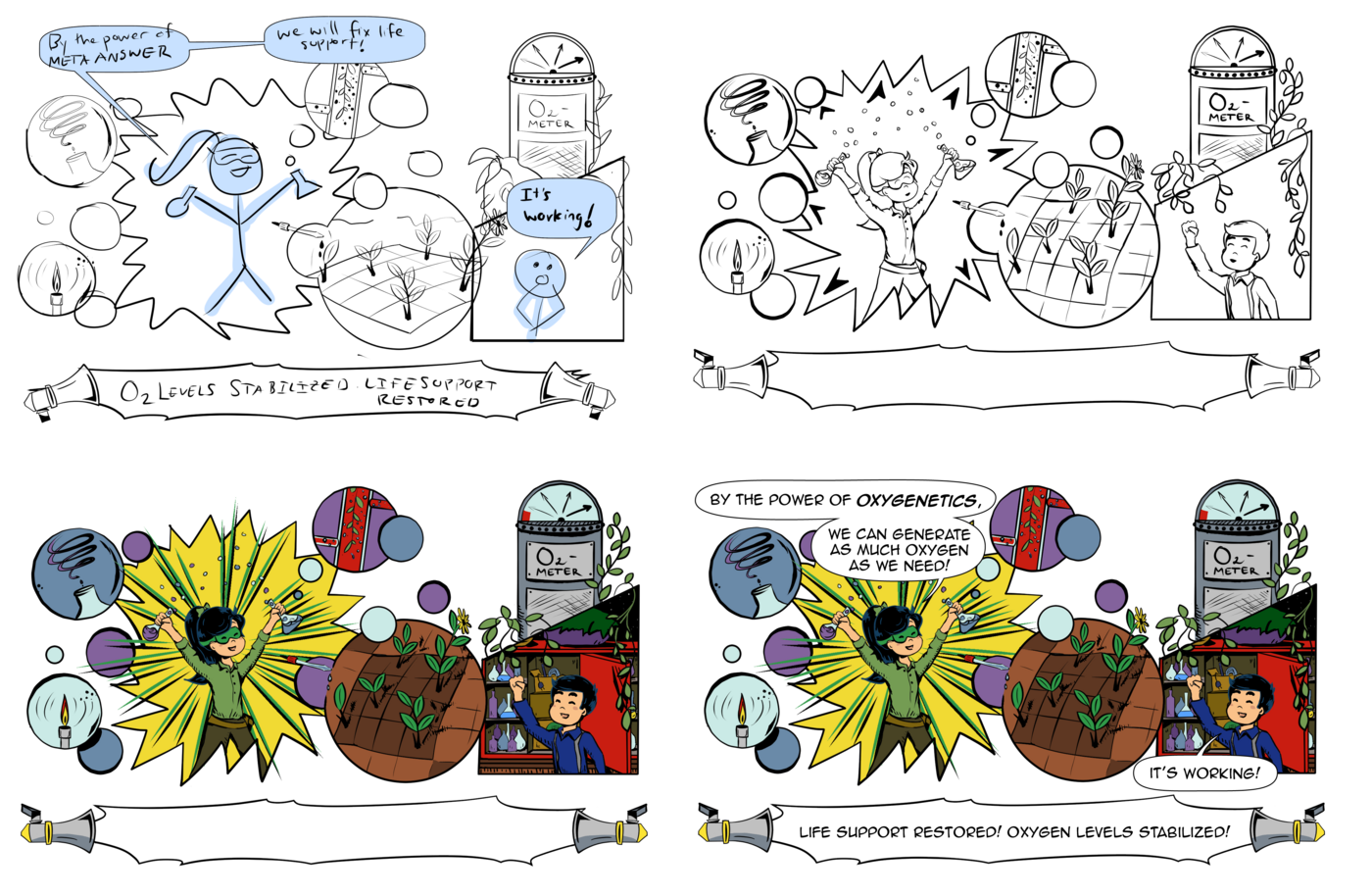
Matt and Emma find the answer to Botany. From left to right, top to bottom: storyboarding again (this was a panel that needed multiple iterations), line art, coloring, lettering
Profile Pictures
Early on, we asked tech to bring back support for teams to upload profile pictures, despite profile pictures not being used in a puzzle this year. Solving a puzzlehunt can be an insulated experience, and we like giving a chance for team personalities to shine through to the rest of the community :)
Then, in early March a teammate posted this in our channel:
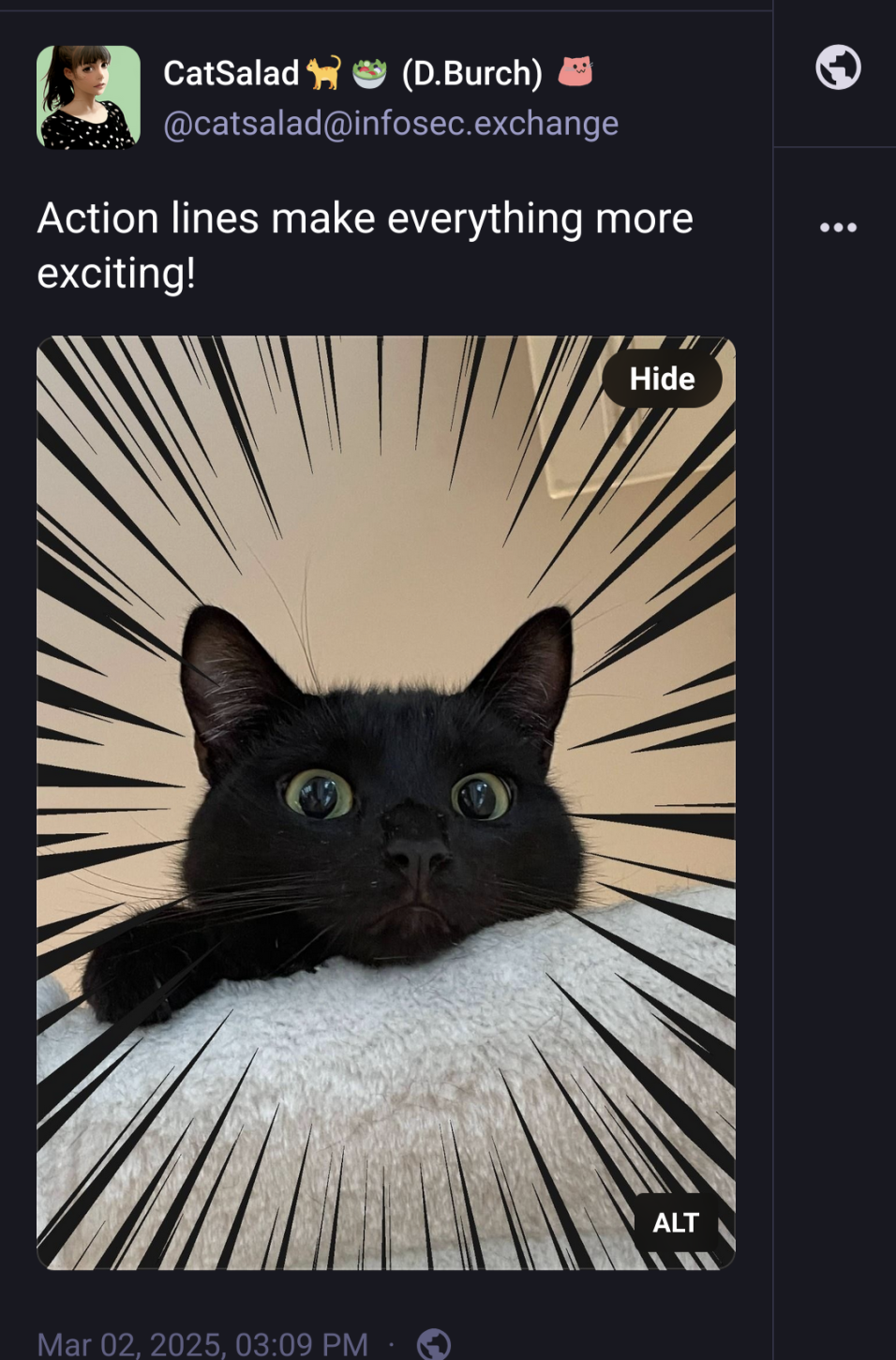
(… they truly do)
For victory photos, we opted for a simple image modification pipeline limited to applying a halftone filter and adding an action line layer on top that we pre-prepared. This way we could edit each profile image within a few minutes. We expected more finishing teams than in past years and were very concerned about workload but still wanted to run victory photos, so this method proved a good idea.
On a sidenote, the lack of a leaderboard and a linear hunt progression meant that even we were confused about which teams would finish next. We tried to pre-upload all potential finishers’ pictures but sometimes missed the cue.
Tools
Our “art stack” included whatever tools each artist was comfortable with. For example: Olga (Wacom Intuos + Clip Studio Paint Pro), Tracey (Photopea), Jasmine (Procreate), Jacqui (PowerPoint + Photoshop). This made sharing raw file formats with layer properties impossible, but usually just sharing PNGs for assets that spanned rounds was enough for us.
Art assets were synced from a shared Google Drive folder for ease of use without interacting with git, and this function was useable without help from the tech team. It was even used after the hunt had started to update last minute assets!
Puzzlehunt Tech
Tech Stack
Our tech stack (tph-site, a fork of gph-site) was largely architecturally unchanged from running Mystery Hunt in 2023 - though we upgraded the versions of most components at the start, to benefit (and fixed a few lingering bugs).
The site runs as a set of 4 docker containers - a postgres database, pgbouncer for db connection management, a Redis instance for websockets and fast state caching, and a hunt container that runs a Next.js frontend and Django backend using uvicorn. See documentation here for more details. At some point in the future we are likely to update the public version of the repo.
The site was hosted on Google Cloud Platform during the hunt - and a free tier of AWS's Cloudfront was used as a CDN. Google Analytics is used on the site - here is a snapshot from 3/31 for fun.

Load Testing
Prior to launching the site, we load-tested our domain with a simulated 500 users across 10 teams loading the comic and spamming Where to Next with websocket requests, using k6 and a modified version of a script Alex Irpan wrote for Mystery Hunt 2023 (writeup). This helped us decide very conservatively to run the hunt on a 32 core (including hyperthreads) 48 GB memory machine at first, which was wholly overkill and scaled down shortly after the hunt started.
Aside: somewhat hilariously, we learned that 500 monkeys typing on a keyboard (i.e. randomly choosing rotations once per user per second) can randomly solve "Where to Next?" - 8 test teams were able to submit "Go to Elevator" within a few minutes of the load test.
Comic Implementation
One of the more involved technical changes for this hunt was the separation of submitting a puzzle's answer(s) and the effects of that answer on story progression and possible further puzzle unlocks. Besides logic changes to APIs on the backend Django server, we created a host of new models for the comic and story flow. Below is an entity-relationship diagram generated for most of the models used in the hunt. New and notable for this hunt were Run, StoryAction{Access,Activation}, Panel, ComicAccess, and Achievement[Unlock].
Our unlock system is an extension of the "deep" system described in Alex Irpan's blog post about MH 2023, which was enhanced to support unlocking everything from puzzles to comic panels, story actions, modals, and notifications. We considered more bespoke unlock systems resembling a graph, but in the end agreed we'd be fine with the flexibility of "deep" to minimize overhead tech costs.
Here is a sample from our massive "deep" tracking spreadsheet (a table of 260 rows x 24 columns) which controlled the unlocking of puzzles, comic panels, and achievements. Scripts were used to apply the data in this table to database fixtures, which were the source of truth for some models.
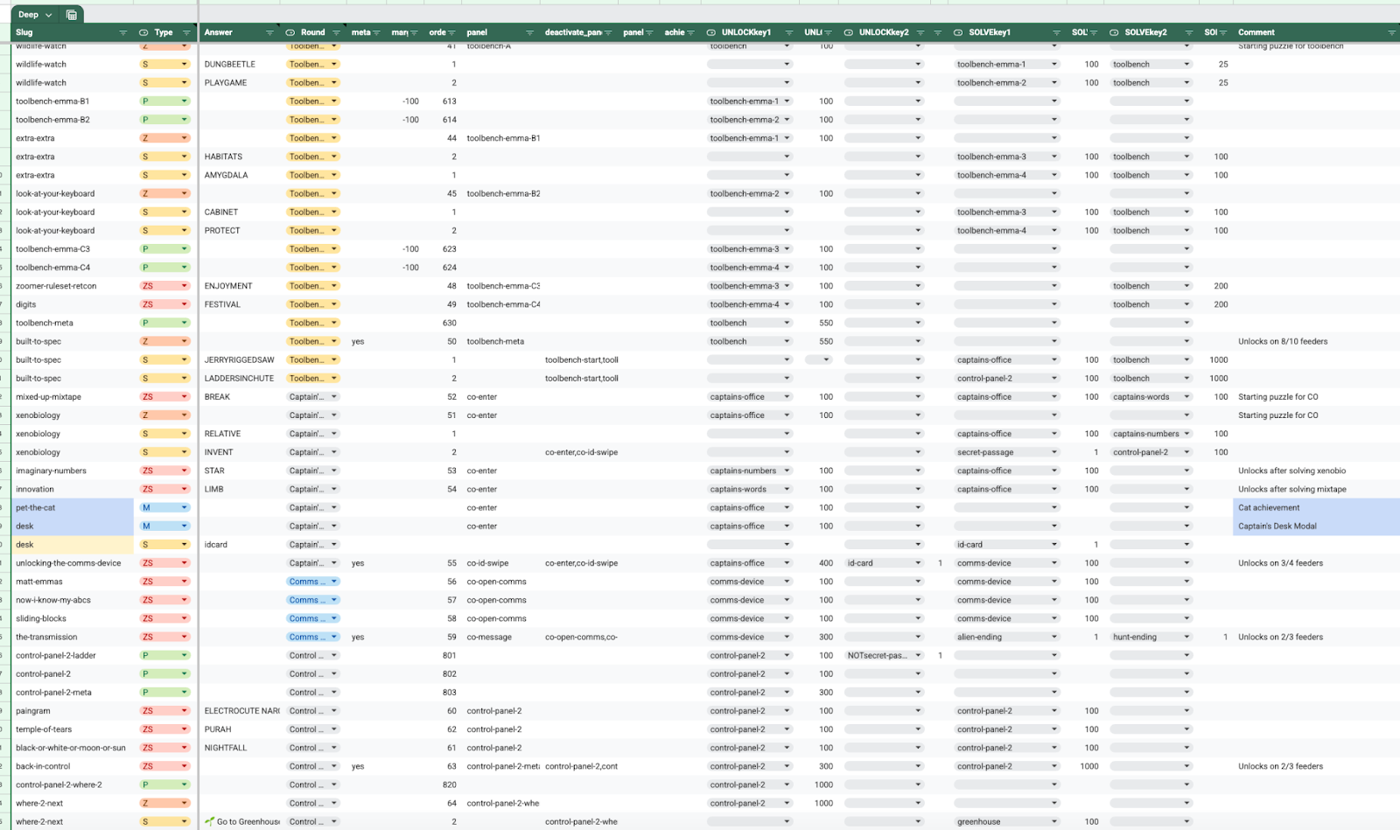
Issues
It's quite difficult to test a website that is used intensely for one week, and at most barely before that. Overall, we had 3 major bugs.
Comic Unlocks
For most of the development of the hunt site (up until maybe 2 weeks before the hunt started), we were computing puzzle and comic unlocks on every GET of the comic page. This was great while developing the comic page, but the intention was to remove it eventually in order to avoid the unnecessary computation on every page load.
Sometime after registration had been open (but still a few weeks before the hunt start date), we did remove this hook and added a different hook to team creation to unlock the first panels. At the same time a script had been written to add the unlocks to the existing teams. However, the hook wasn’t deployed until roughly 1 hour before the hunt started, and the script had been forgotten about. We panicked for a few minutes once it was clear teams were not seeing anything. After rapid debugging, we remembered the existence of the preexisting script to check the unlocks for teams. The script was executed 8 minutes after the hunt had started. We watched the unlocks roll in and breathed a sigh of relief. Only about 50 teams had access for the first 8 minutes - and only 20 or so had used it.
To the uninitiated, we expect that most solvers attributed the downtime to standard infra scaling issues. The irony is that our site was perfectly scaled to handle the load at the beginning of hunt, and then some.
Websockets?
At 10:48pm PDT on Saturday March 29th, one day after the hunt started, Alex was awoken by a call reporting that the hunt site was hard down.
Alex could not ssh into the production instance and went to check on the VM in GCP.
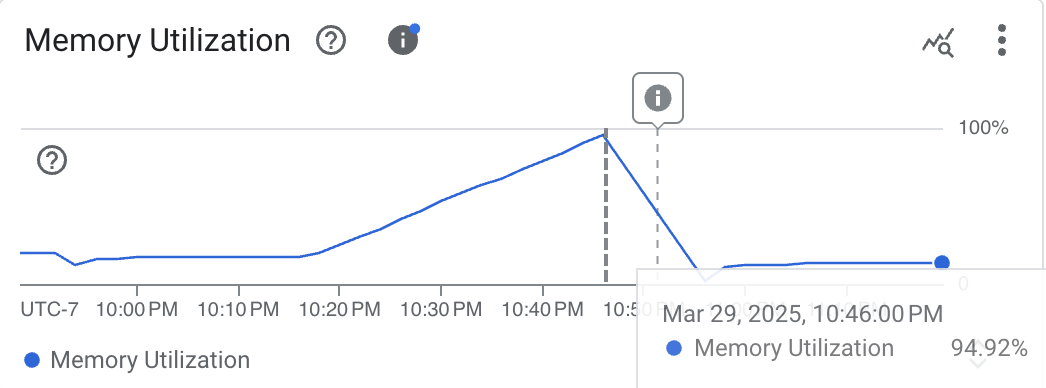
For some reason, the server had rapidly started consuming memory. With no time to debug or even ability to access the production VM, the VM was power cycled. The site was back and debugging was deferred in the name of sleep. Alex was woken up 2-3 more times that night anyway - sometimes with reports of “websocket issues” - and the VM was sometimes restarted before the site went down. A small number of observations were performed: namely one or two uvicorn workers would have some combination of high CPU or memory usage, but it was late and preventing the site from going down was the priority.
In the morning - logs and stats were examined. At least partially because of the tropish nature of websockets issues in online puzzlehunts, when the reported symptom was “websockets are slow / broken”, and the “quick fix” of restarting the server worked, we started looking into websockets.
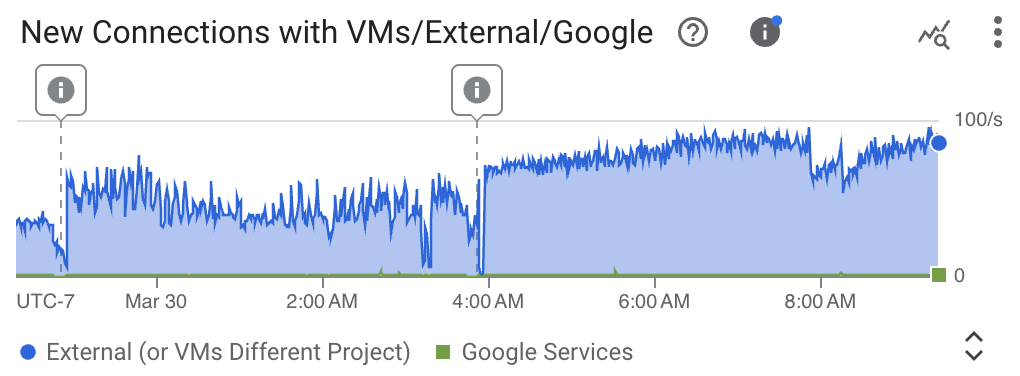
We noticed that each time the server was restarted overnight, the number of connections per second experienced a sharp step increase. Inspired by this observation, we found that our client websocket code, upon loss of connection, would retry every 1 second indefinitely. The theory was that the many tabs open in the many browsers were all attempting to make websocket connections. We implemented exponential backoff and a max retry limit on the client — though users would need to refresh to get the updates. We hoped this would mark the end of these infra issues, though in the back of our mind we knew that these connection rates should not be high enough to cause any real issues.
Where 2 Debug Next: Electric Boogaloo
Sadly the hope the infra issues would be resolved was a false hope. The runaway memory issue occurred around 15 more times over the next 5 days. We considered several times how the only possible hypothesis we could come up with is that of an infinite loop with a growing data structure or other memory leak. Multiple people read over the relatively small number of while loops in the codebase and nothing stuck out.
Probably a little bit later than we should have we decided to roll up our sleeves and be ready to determine what code was running at the next recurrence. We prepared a script to sample the python stack trace of the running uvicorn processes that were serving our backend requests using PyStack. Lo and behold, the next time the issue recurred we discovered that we were infinite looping in a file called “triangley_stuff.py” - used for checking paths in Where to Next? and Where 2 Next: Electric Boogaloo. We had a good laugh/cry and quickly implemented a limit to the number of iterations the loop could run.
A bit later, it was determined there was a single character transcription error that effectively created a one way edge in our graph! This was the fix:
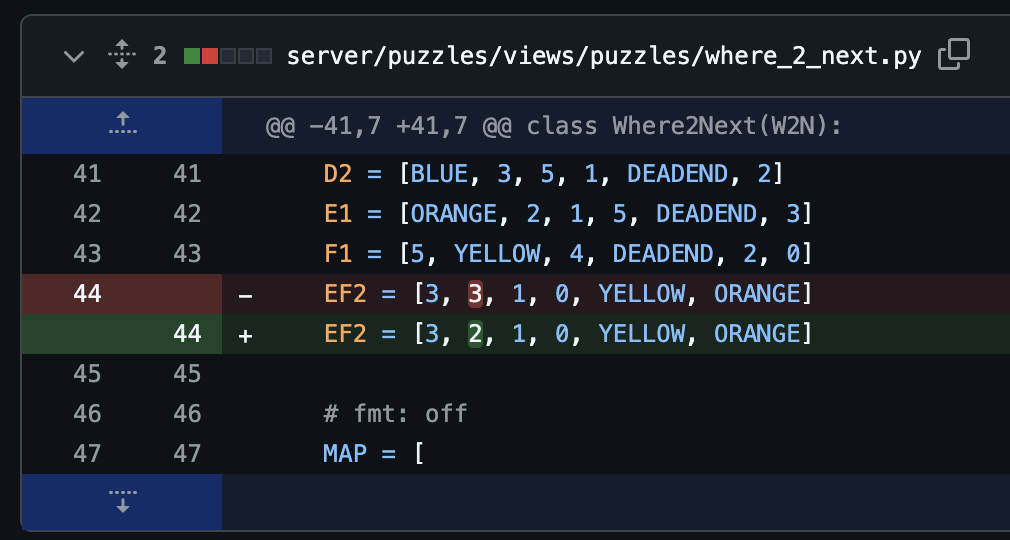
Second hilarious aside: if we had chosen the more complex Where 2 Next: Electric Boogaloo instead of Where to Next to run the load test on we would have triggered the issue in testing.
Appendix
Stats
Decisions
Where To Next? (Note that in the sequel puzzle, Where 2 Next, everyone has to go to the Greenhouse first since they do not have the ID card to enter the Cockpit yet.)
- 74% (422/570) of teams picked "🛗 Go to Elevator" first
- 26% (148/570) of teams picked "📦 Go to Cargo Shelf" first
- 10 teams found the "🔄 Turn Around" solution before seeing the instructions on how to get there (and were awarded the 🧠 Foresight achievement for this) - The C@r@line Syzygy, in space, no one can hear you ✈✈✈ (nyeeow), Vehouston we have a problem, laB P Crew, Magical Flavor, 🚀🚀🚀, Hee-ho, solosolver, International Mushroom captive Organization , 24601
Out of the 402 teams to fully solve Hull Breach:
- 377 (94%) teams SUITed UP before getting TAR OUT
- 24 (6%) teams got the TAR OUT before SUITing UP
- 4 (<1%) teams got TAR OUT or SUITed UP withoutTINKERing first
Out of the 290 teams to fully solve Built to Spec:
- 139 (48%) teams built a JERRY-RIGGED SAW first
- 151 (52%) teams built LADDERS IN CHUTE first
Hunt Progression
Out of the 603 teams who solved at least one puzzle…
- 486 (80%) teams died at least once (gaining the Timeium watches)
- 402 (67%) teams patched the Hull Breach
- 351 (58%) teams built something at the Tool Bench
- 260 (43%) teams restored the ship's power at the Control Panel
- 204 (34%) teams logged into the Captain's comms device
- 175 (29%) teams exploded at least once
- 168 (28%) teams solved Plot a Course
- 160 (27%) teams solved Botany
- 153 (25%) teams solved The Transmission
- 142 (24%) teams finished the hunt
More Stats
- 2214 individual participants on 763 teams signed up for the hunt
- teammate HQ answered 10773 hints
- teammate HQ graded 3790 submissions for Make Your Own Metapuzzle and 240 for The Transmission, of which 3476 were accepted and 554 were rejected. 664 of the 3476 were auto-accepted.
- The average number of tries needed to complete The Reactor was 5.7
- Of the teams that finished the hunt, how many timelines did they take?
- average: 39
- median: 34
- min: 15
- max: 259
- The total number of timelines across all teams was 10592.
- The total number of actions submitted on the comic page was 144801.
- The theoretical minimum number of timelines needed to complete the hunt and see all the rounds is 7.
- Now I Know My ABCs was intended to have a mini leaderboard, which was scrapped (along with related achievements) due to time constraints as the hunt drew near. But here are the top 5 teams for each level at the end of the hunt.
| Rank | Team | Level 1 | Team | Level 2 | Team | Level 3 |
|---|---|---|---|---|---|---|
| 1 | ProgChamps | 17.38 sec | Deepspace Delving Disasters | 32.37 sec | Vulpecula | 4.06 sec |
| 2 | Where No Llama Has Gone Before | 33.67 sec | myrrhy synth trysts | 57.03 sec | 1cool3me | 14.61 sec |
| 3 | Ejected Conspirators of /r/PictureGame | 56.09 sec | Cosmos Byss Contingent | 1 min, 1.78 sec | Les Gaulois | 50.86 sec |
| 4 | weeklies.enigmatics.org | 56.50 sec | The Providence Chromatic Aberrations | 1 min, 11.57 sec | Astronomical Mathemagicians Observe Grave Uncertainties in Space | 59.29 sec |
| 5 | stɹeɪjə maɪt | 58.06 sec | Ejected Conspirators of /r/PictureGame | 1 min, 25.48 sec | Deepspace Delving Disasters | 1 min, 10.17 sec |
Achievements
Besides the publicly visible achievements on the Crews page, here are the rest of the achievements!
Story-related achievements: (any team finishing the hunt will gain these)
| Icon | Name | Description |
| ❓ | Choose Your Own Adventure | Make a decision |
| 🔄 | Whoops | Use the watch for the first time |
| 🩹 | Day 1 Patch | Fix the Hull Breach |
| ☄️ | Cryptic Cryptid | Finish the Spacewalk |
| 🛠️ | Duct Tape and a Prayer | Build something at the Tool Bench |
| 🔋 | does anyone have a charger | Restore the ship's power |
| 🖥️ | hunter2 | Login to the captain's comms device |
| I Saw Red Vent | Take the secret passage to the Control Panel | |
| 🔒 | Safecracker | Unlock the safe |
| 💥 | BOOM | Experience a fiery death |
| 👽 | Xenolinguist | Complete the Alien Ending |
| 📍 | Ludicrous Speed | Complete the Cockpit Ending |
| 🪴 | Fan of Breathing | Complete the Greenhouse Ending |
| ⌚ | Out of Time | Destroy the watch to fix the reactor |
Bonus/fun achievements: We also had some achievements which were not found through the hunt progression itself.
* denotes achievements that were "secret," so teams could not see that these existed until earning them.
| Icon | Name | # of Teams | Description |
| 🌌 | Connect the Dots | 204 | Solve the hidden bonus puzzle |
| 🐈⬛ | Meow | 211 | Pet the cat |
| 👏 | High Effort | 112 | Send us a submission we really like (We granted this for both Make Your Own Metapuzzle and The Transmission submissions) |
| 🧑🚀 | Extra-Vehicular Extra-Credit | 82 | Solve all cryptics in the Spacewalk Round |
| 💤 | Snooze Button | 98 | Reset a timeline with no puzzle answers submitted |
| ✅ | Precise | 523 | Solve 3 puzzles on the first try (no wrong answers) |
| 🧉 | Spirit of Teammate* | 96 | Solve a puzzle after 15 or more incorrect guesses |
| ◀️ | Backsolver* | 393 | Backsolve a puzzle |
| ⏱️ | Determined* | 436 | Solve a puzzle more than 48 hours after first unlocking it |
| 👍 | okay* | 19 | Ask HQ for an achievement |
| 🧠 | Foresight* | 12 | Notice something a little earlier than expected(We granted this for teams that submitted Turn Around before getting to a bad ending, as well as a few other special cases) |
| ❌ | Deep-space Bounty Hunter* | 9 | Find and report an erratum |
| ✈️ | Wrong Puzzlehunt* | 18 | Submit FAIRPLAY as an answer to any puzzle |
Our general design principle was to mark "secret" achievements as hidden if:
- We did not want to encourage teams to play suboptimally to get them, but wanted to reward teams that happened to get them anyway (e.g. 🧉 Spirit of Teammate, ⏱️ Determined)
- We expected very few teams to get them (e.g. 🧠 Foresight, ❌ Deep-space Bounty Hunter)
- They referenced an inside joke that not every team might get (e.g. ✈️ Wrong Puzzlehunt)
Submissions & Fun Things
Make Your Own Metapuzzle Submissions
In this puzzle, teams are presented with a chat interface to talk with 10 (fictional) puzzle authors who give constraints for their puzzle answers after you help them out with some scavenger hunt tasks which are all submissions. Humans would look at these submissions. Here are some of our favorites.
AmaranthAmberjack 2: "i need a recording of a portion of a list song, but with the items in the list changed. no more than 30 seconds."
- notaplanet:
AmaranthAmberjack 4: "ok so we need a 30 second recording of a weird al style parody of a song."
- Han Solved First:
- New Difficulty [Reform's Extra]:
- Ponx:
BurgundyBarracuda 2: "We need the word "SPACE" written in an unusual set of twenty-six things."
- Look, Matt…I can see you're really upset about this…I honestly think you should sit down calmly…take a stress pill and think things over…Emma…stop. Stop, will you? Stop, Matt.:
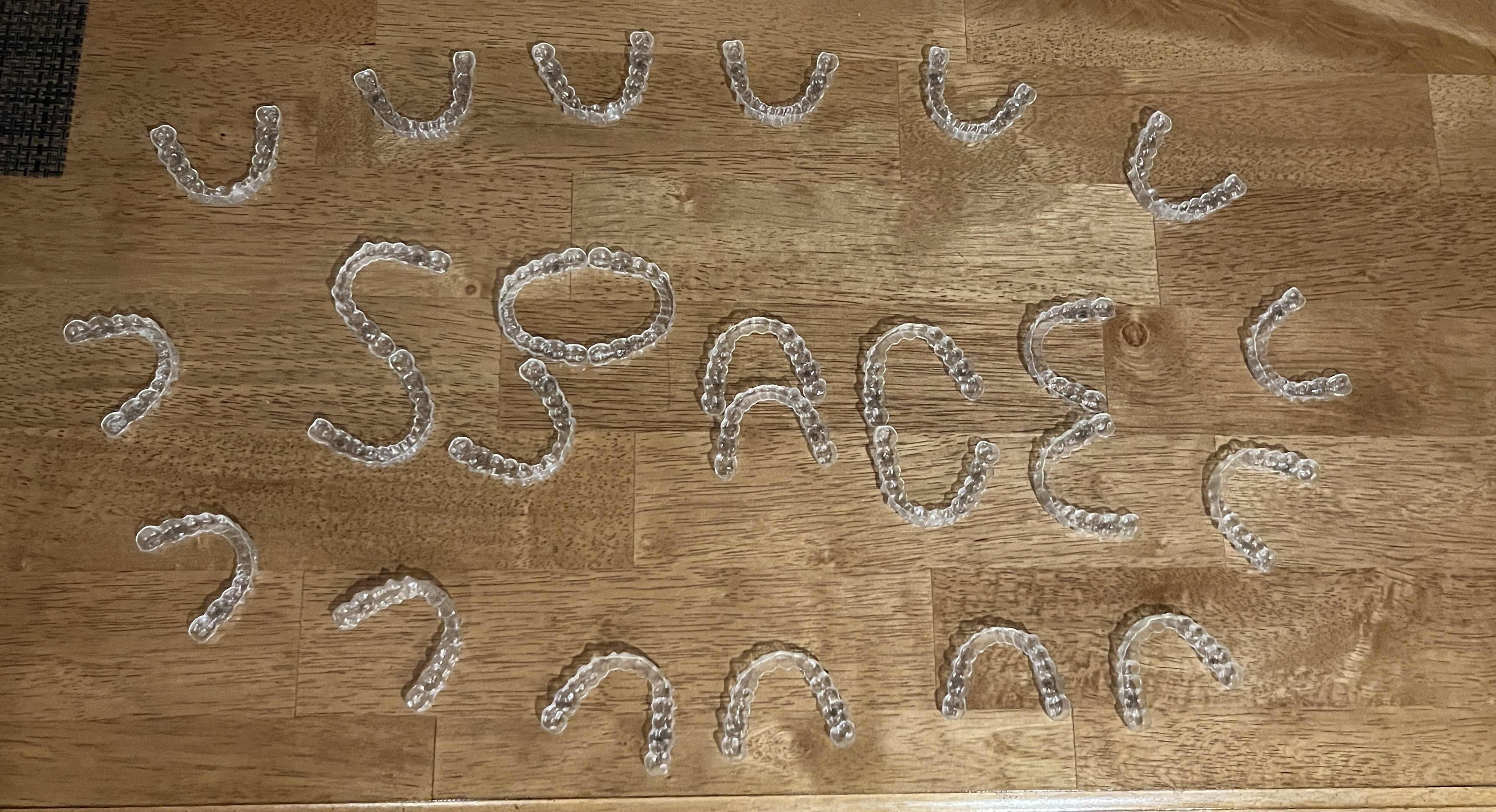
BurgundyBarracuda 4: "We need a spaghetti'd 4-answer metapuzzle including the answer "DOCTOR". Don't worry too much about quality."
- ??????:
 (solution)
(solution)
CrimsonCarp 2: "Can you show me how to center a div?"
- Teyvat Travellers:
 (submitted as a .docx)
(submitted as a .docx) - Where No Llama Has Gone Before:
Certainly, CrimsonCarp. Here are several ways to centering a div.
[processing...]
1. If you're using Python, you can center a string using the `.center()` method. Try this:
>>> "a div".center(15)
' a div '
2. If you're using Microsoft Word, select your text and hit Ctrl-E.
3. In Google Slides, select your object or group and right click on it.
>>> no I mean in CSS
[processing...]
Ah, I understand -- you are a puzzler. "Center a div in CSS" can be a cryptic wordplay meaning to take the central letter of "A DIV IN CSS". Your answer is "I"!
>>> no, I mean, I have a React component that returns a div that has to be centered on the page
[processing...]
You can center an element horizontally using the <center> tag.
>>> I JUST WANT TO CENTER MY DIV BOTH VERTICALLY AND HORIZONTALLY
[processing...]
I'm sorry, you have run out of SmallLlamaPT credits for the month. To upgrade to the Pro plan for only $200 and ten free hints per month, click here.
Thanks for chatting!
CrimsonCarp 4: "Can you show me what a <marquee> looks like?"
- Amateur Hour:
- Ponx:
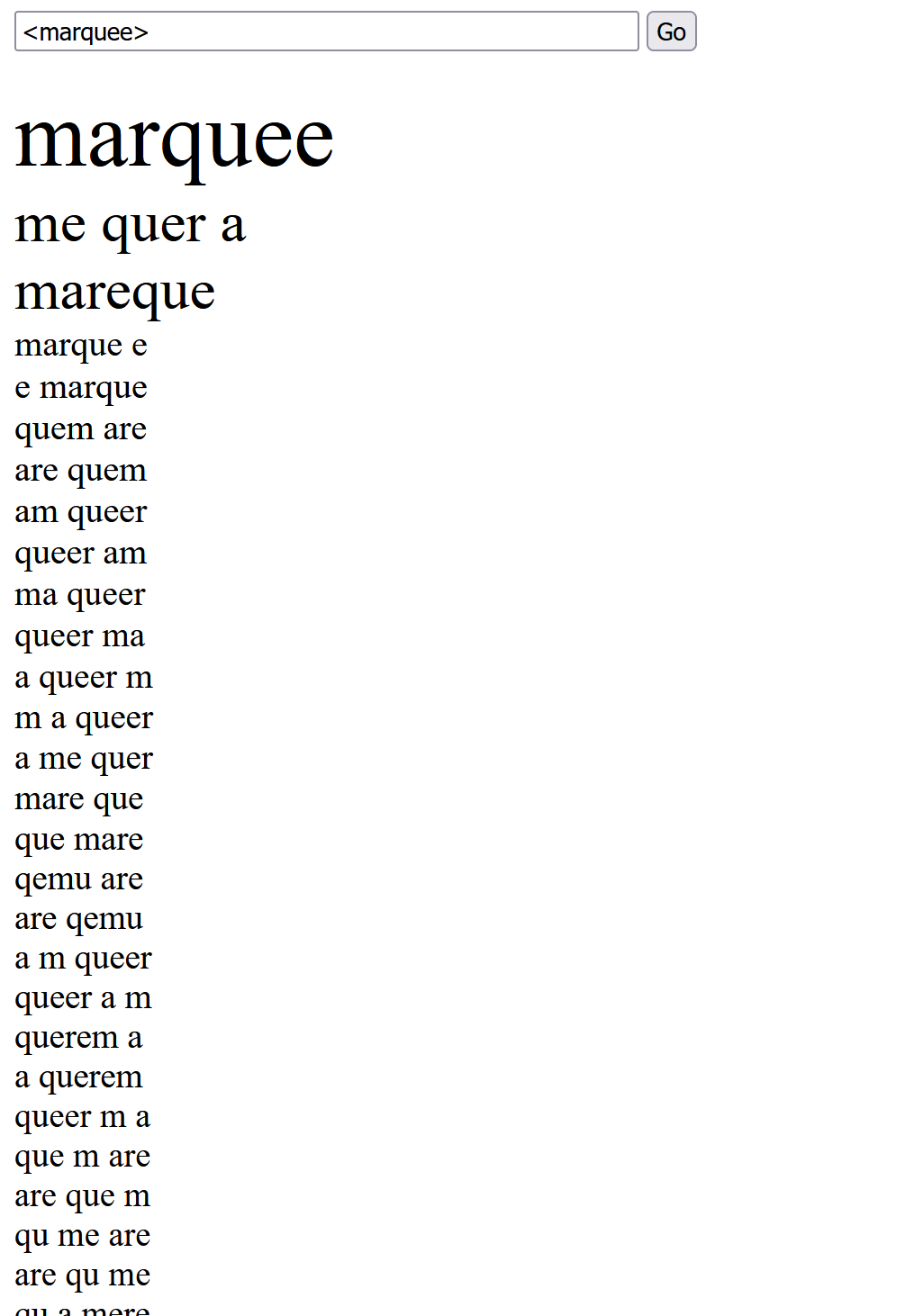
EchinaceaEel 2: "can you send me a custom MTG card of a character who has appeared in a puzzle hunt?"
- BestBeans:
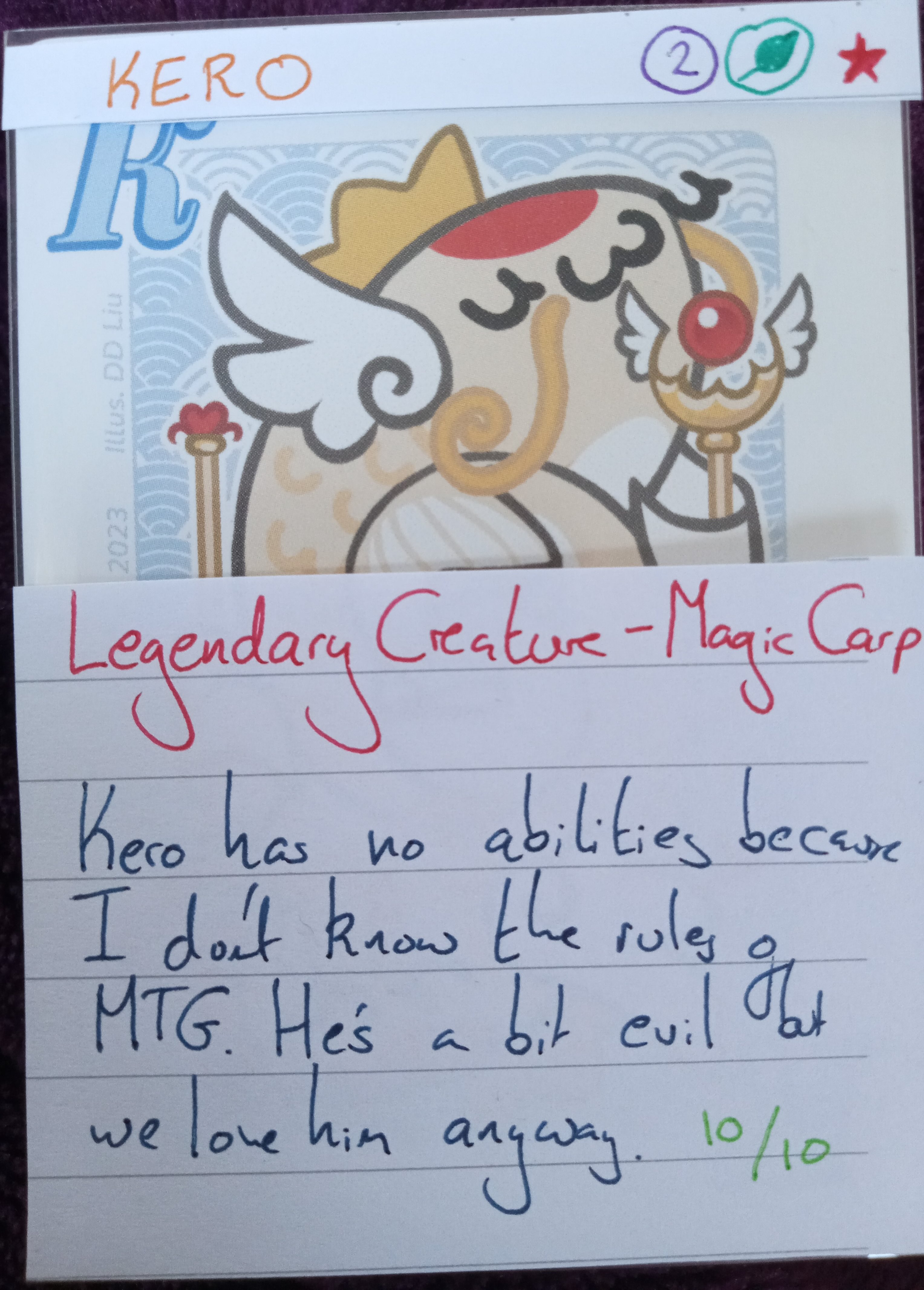
- Team Peggle:
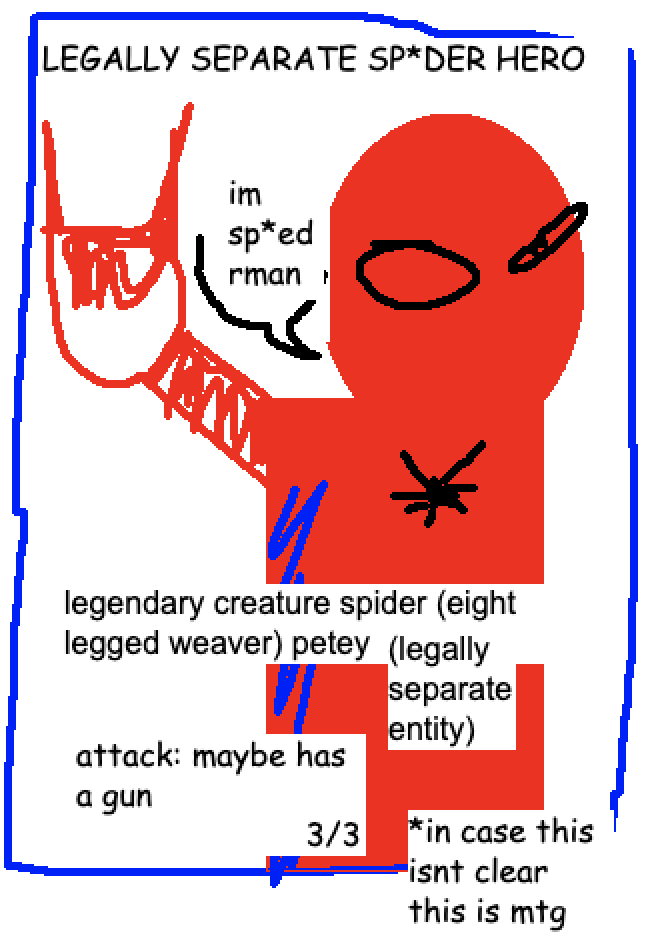
- The Wob Blizzards:
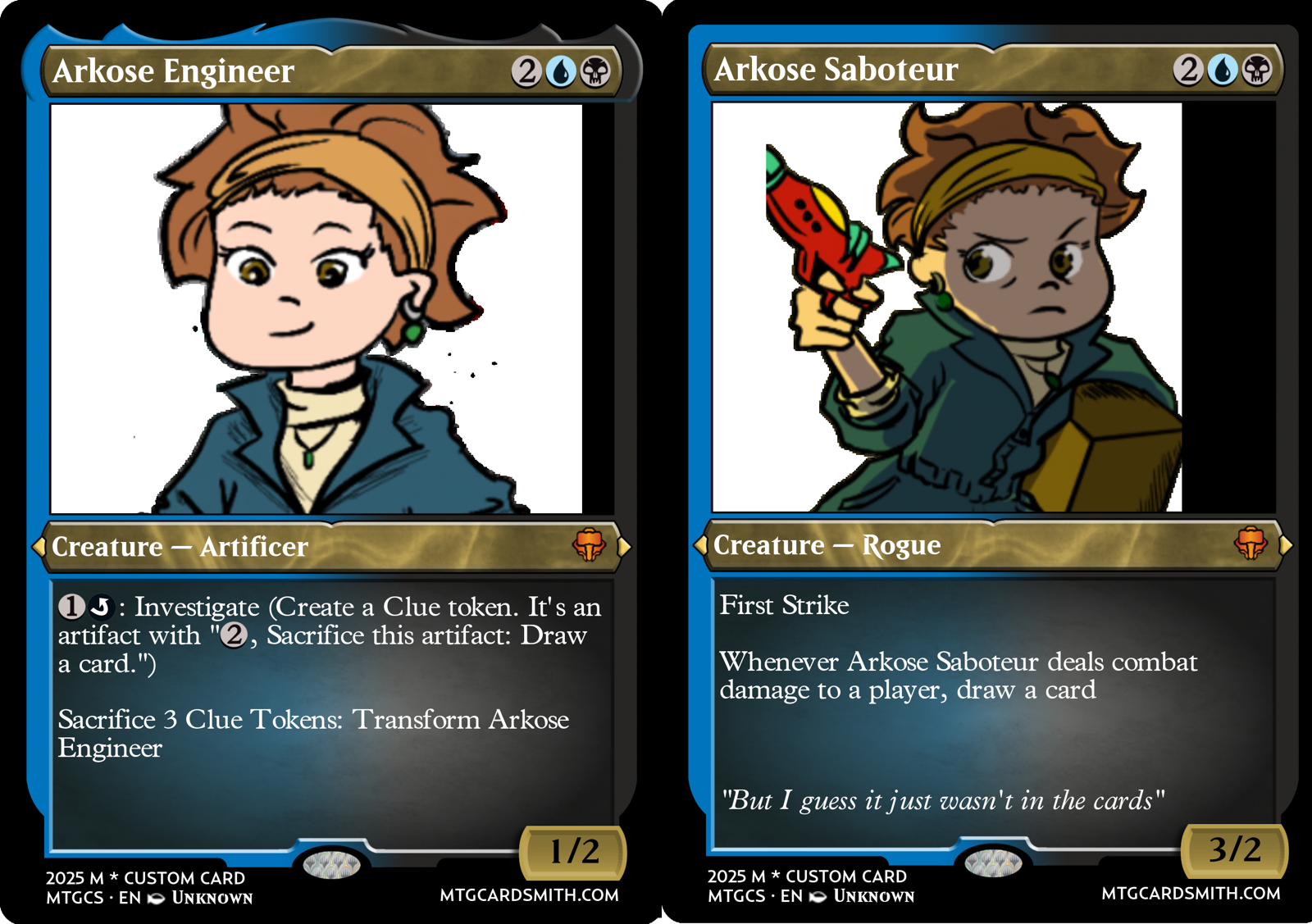
EchinaceaEel 4: "Uh, turns out we needed a custom card of a character who has appeared in a puzzle hunt for literally any card game but magic."
- 🥦Broccoli Brawlers🥦:

- New Difficulty [Reform's Extra]:
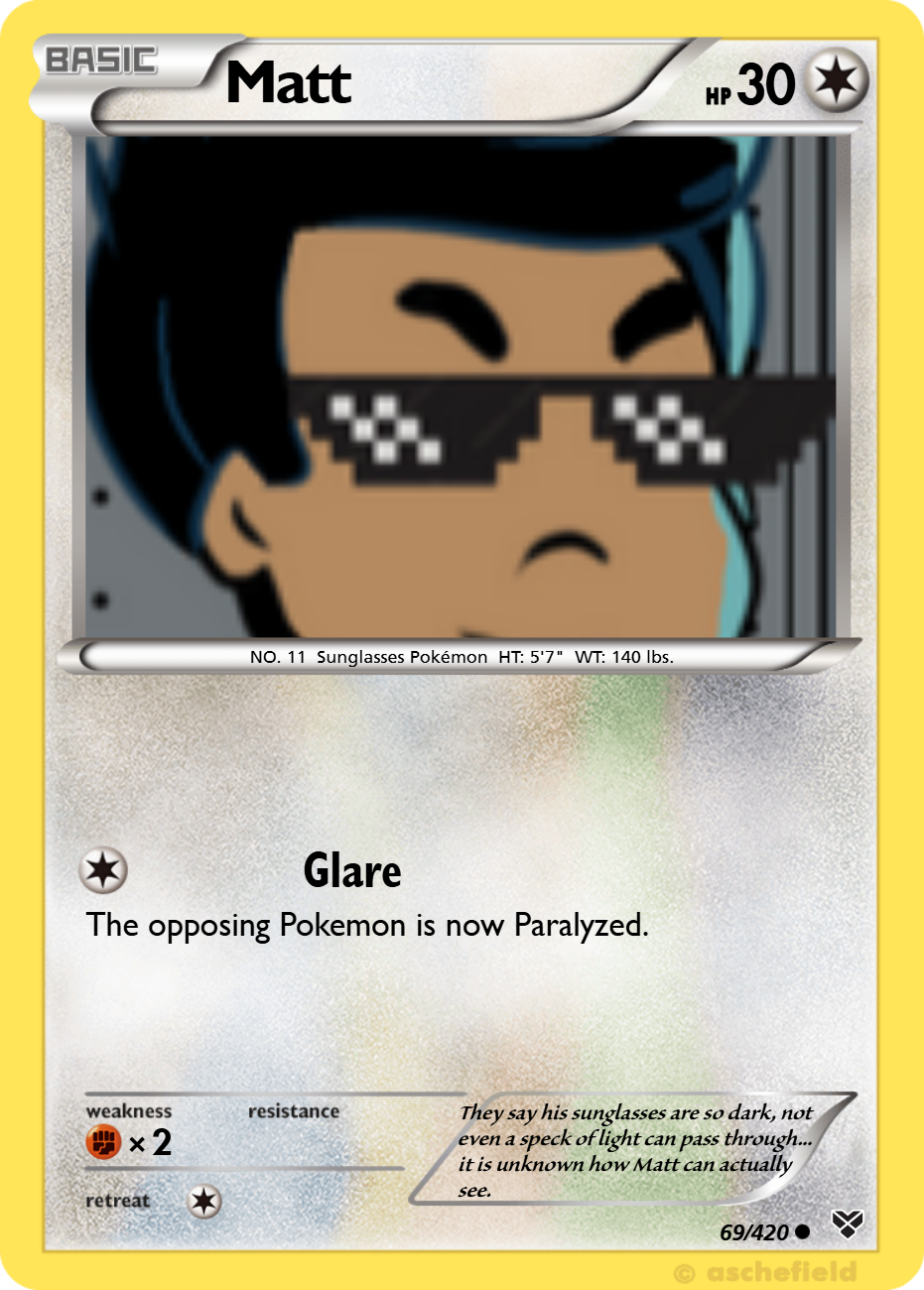
- puzzles too hard :c:

FuchsiaFlounder 2: "Request: A mascot for [TEAMNAME] here."
- As Riddles Traverse Extraterrestrially, Mathemagicians Invade Space!:
 Credit to Egail
Credit to Egail
FuchsiaFlounder 4: "Further Request: A t-shirt design for a puzzle hunt referencing a puzzle appearing in that hunt."
- 🥦Broccoli Brawlers🥦:
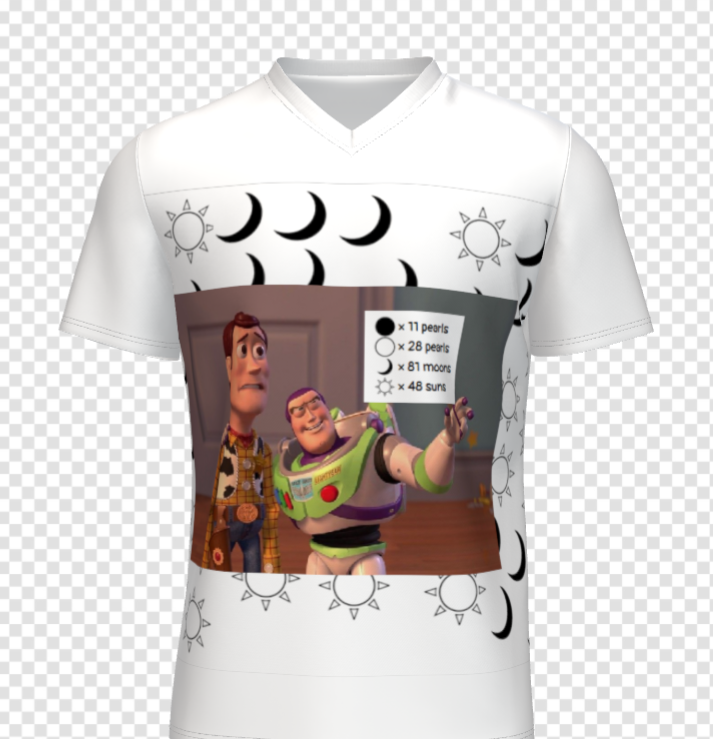
ImperialIde 4: "A cipher variant logic puzzle is needed."
- The Providence Chromatic Aberrations:
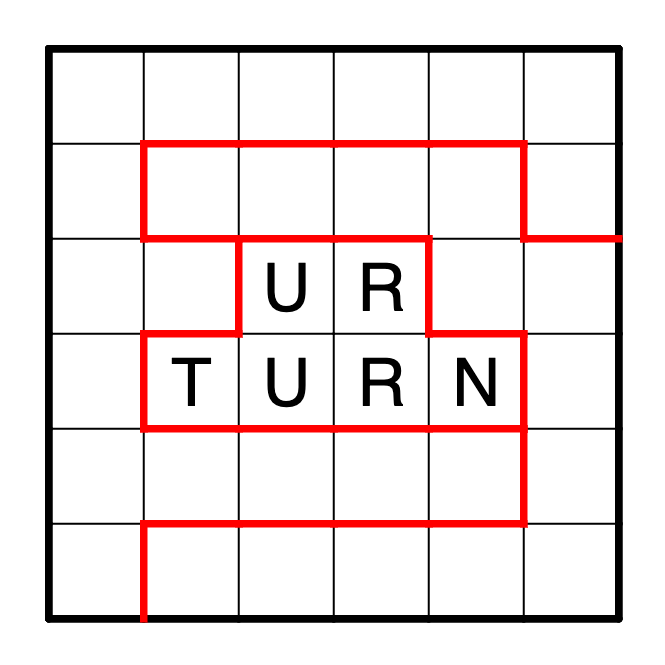 Puzzle link
Puzzle link
Podomorph Transmission Submissions
In this puzzle, we asked teams to send the Podomorphs a distress signal using the language they've been learning throughout the round. The submission needs to be in the form of a video, but teams can exercise creativity on exactly what medium that is. We thoroughly enjoyed the variety that we received:
- Recorded videos of team members standing next to/in front of each other, moving their limbs
- Spliced together videos, each of 1-2 arms
- Many teams built a Podomorph out of various objects, and took a video of moving the arms around. These are some of the materials used:
- Play-doh
- Pipe cleaners
- Electrical wires
- Legos
- Tin foil
- Cooked spaghetti (moved around using chopsticks 😆)
- Digitally-animated videos
See the full gallery of select submissions!
Incorrect Answers
- 49 teams submitted LUCY DIES or LUCY DIED to Under Control
- 46 teams submitted CATBOYS to Laser Pointers
Favorite Profile Pics
We particularly enjoyed these teams' creative profile pictures (that were not generated by AI):
- Cats: Puzzle Solution Doxxers, Team Avatar, chicken, Sesame 🐈, Charlie's Angels, Covering Midway Unfortunately, Insert T-Swift Song Here, jayyy, S.S. Trixie Fig, FluffyElephants, Q-Team
- 42.29453, -82.74843
- We Believed Her Lies
- DisasTaurus Complexity
- SpaceBandits
- As Riddles Traverse Extraterrestrially, Mathemagicians Invade Space!
Timeium Thieves
These teams must have used the watches in real life to make team names that were strangely prescient:
- Spaceball One (a ship used in Starship Battle)
- We Believed Her Lies (Under Control meta cluephrase)

- In Case of Emergency Solve Puzzle (very beginning of comic)
- brut force (thematic team photo)
- Vehouston we have a problem
Fun Timeline Names
During the hunt you could update the names of your timeline runs. Here's a selection of ones we found amusing. Multiple names from the same team are delimited with /.
- Spacewalk reactions
- Spacewalk - OH NO GOD PLEASE NO NOT THE CRYPTICS PLZZZ - 謎星叫
- cryptics :) - The Team That Is Not Now Named "Han Solved First"
- Oops! All Cryptics! - Quasar Detectors
- Abandoning the Ship to do Cryptics - Vehemars
- Toolbench
- Bench III: The Benchening - Spin My Hovercraft
- i guess il just go into the tool benchh. then .s ince nobody wants me. i gues sil just become a screwdriveer. i guess ill just - jඩker
- never order from ikea again man / Ikea again / Can we stop going to ikea? - The Stars Beckon Illuminatedly
- how ambient are these beetles anyway??? - surely something factorio related
- DIY Workshop 2 : Attack of the Clones / DIY Workshop 4 : Are you reading this? - Time Vultures
- Forgetting the ID card or proteins (there were a lot of these)
- I forgot the Proteins in the Car - Time Vultures
- forgot to grab the id card so it's back to botany - Z-ro Gravity
- we amogus'd but left the card behind - it's time to pump
- sussy venting / sussy venting (taking id card) / sussy venting (final) (real) / sussy venting (final) (real) 2 ACTUAL - Team Eagle Time
- Reactor / end of the hunt
- The Boss Door without the keys / The Boss Door with half the keys / The Boss Door for real I swear - Time Vultures
- Keep Talking and Nobody explode (but us) - Time Vultures
- whoops we blew up - Vehemars
- fiery reactor death (with oxygen!) - 17th Blinking Warning Light That's *Probably* Fine
- god run / god god run / god god god run / god god god god run / true astro galactic god god god god god god run / god run (REAL) / 📍 THE URN (REAL (FINAL (FINAL))) - Ejected Conspirators of /r/PictureGame
- The One Where We Win [Editor's Note: they did not win.] - ░ BLOCK ELEMENTS BEN DAY DOTS
- Lucy
- WHY DON'T WE JUST THROW LUCY IN THE BRIDGE - Defying Grality
- holy shit lucy is an alien from the future * - KaBaL
- LUCY EATS AT FIVE GUYS - da hintslayers!!!
- Elevator - Checking to see if we can steal Lucy's gun before she shoots us - Puzzles are Trans Culture
- Comments on timelines
- Will opening 100 timelines give us an achievement? / If the next one doesn't give us an achievement I'm gonna be really pissed / ???? WTF WHERES THE ACHIEVEMEMT???!? - 謎星叫
- There are a lot of extra timelines here. Why, you ask? Jumping in time is fun! - 2 Stumped 2 Furious
- THIS IS AN EXACT DUPLICATE OF TIMELINE 1. NO HIGHLY ESTEEMED DEEDS ARE COMMEMORATED HERE - Quasar Detectors
- Sorry someone misclicked - As Riddles Traverse Extraterrestrially, Mathemagicians Invade Space!
- Misc.
- look at me im the captain now - Spin My Hovercraft
- Just kidding, the cargo shelf is where the cool kids are. Solved hull breach 2! - 2 Stumped 2 Furious
- Dinosaur Desecration Timeline - 2 Stumped 2 Furious
- WE OPENED THE SAFE!!!!!!!!!!!!!!!!!!!!!!!!!!!!!!! and also created oxygen * - KaBaL
- Oh Yeah, It's Funky Dance Time - myrrhy synth trysts
Other Submissions, Memes, and Stories
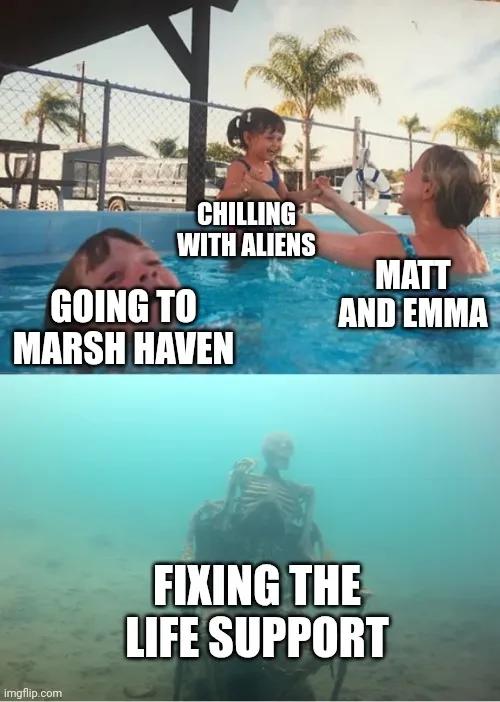 Emergency Council of r/PictureGame
Emergency Council of r/PictureGame
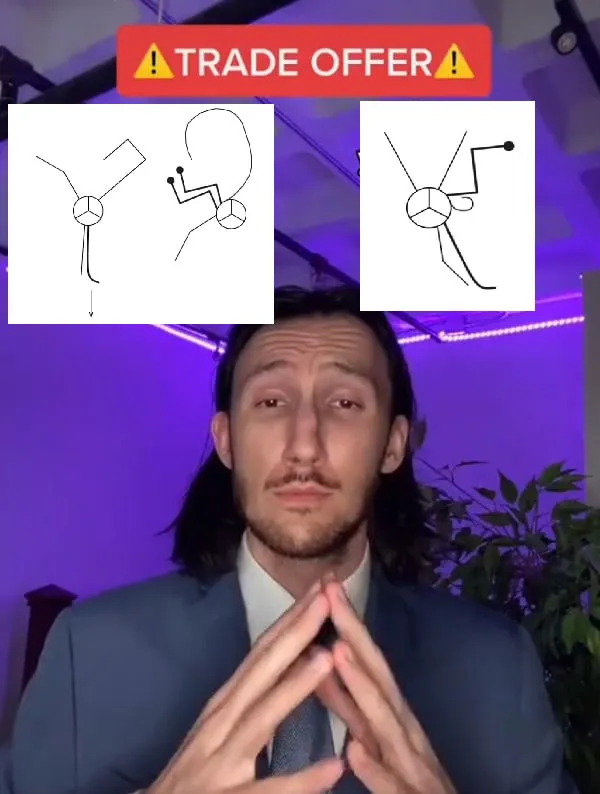 Starship SarMeg
Starship SarMeg
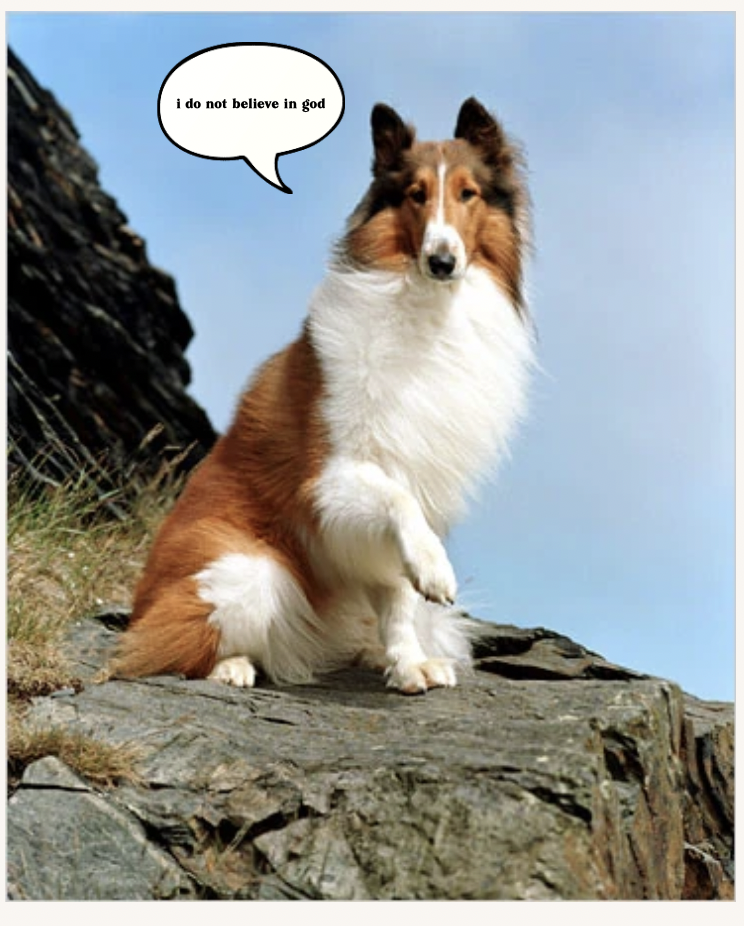 Vehemence
Vehemence
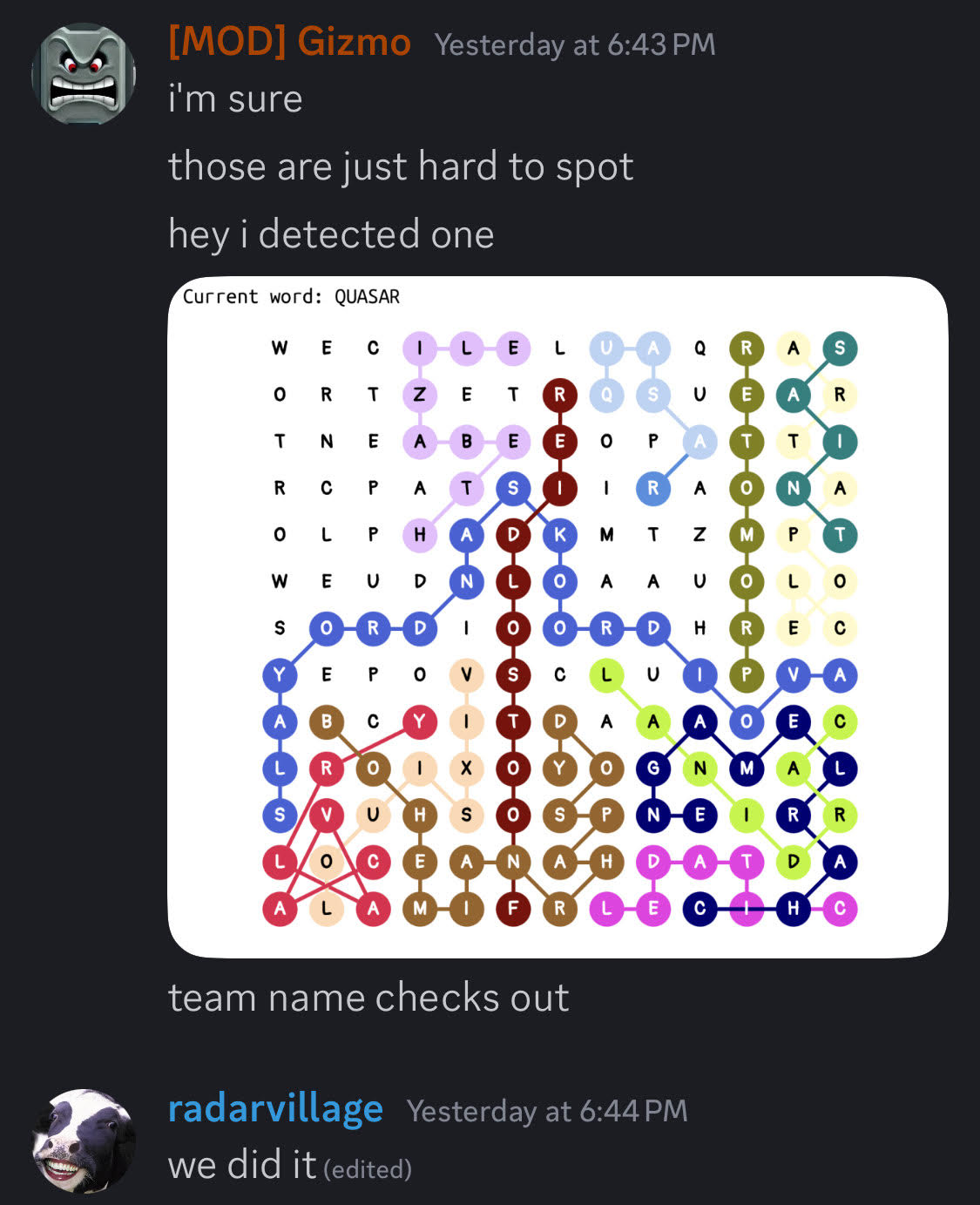 Quasar Detectors
Quasar Detectors
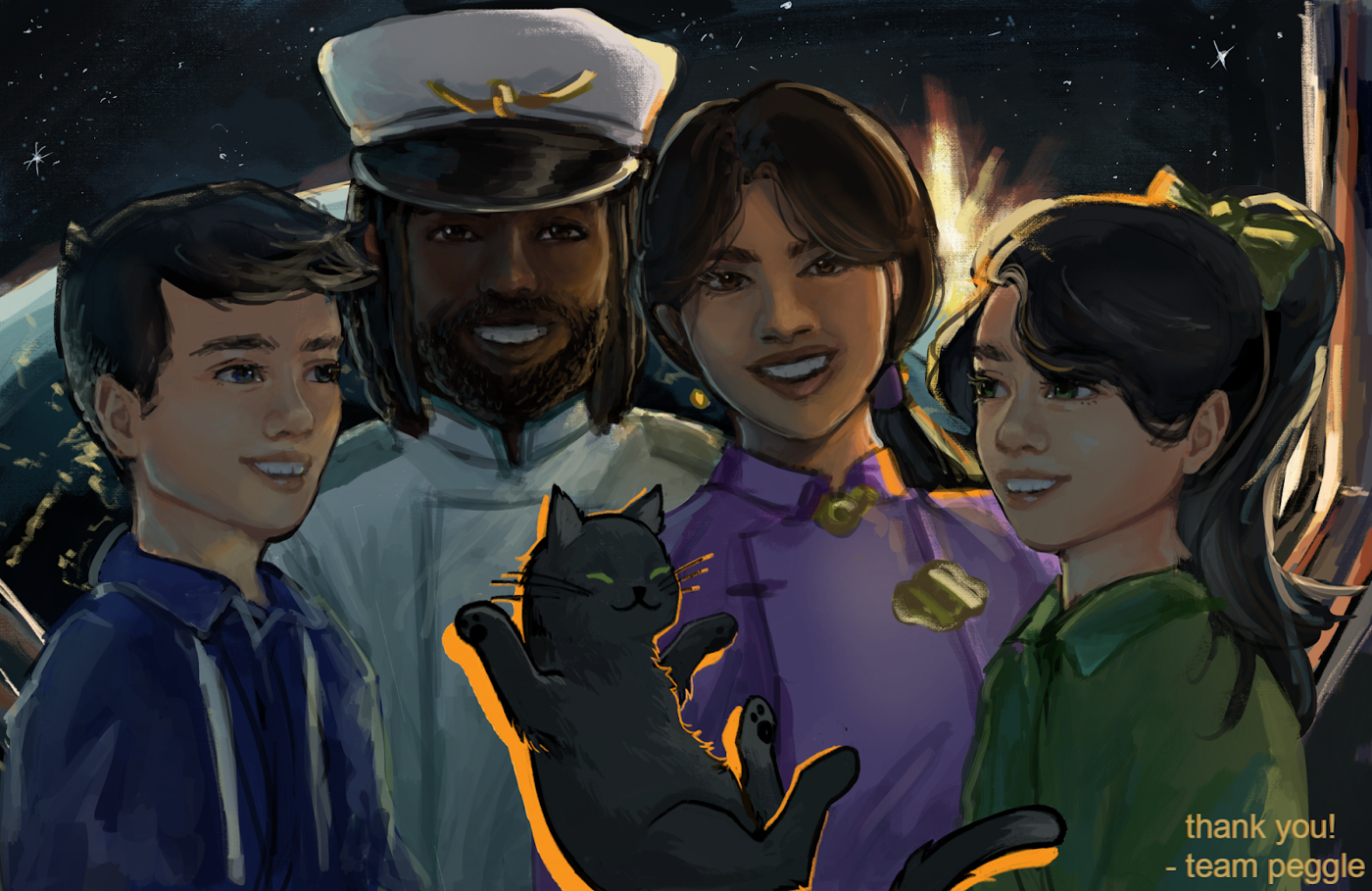
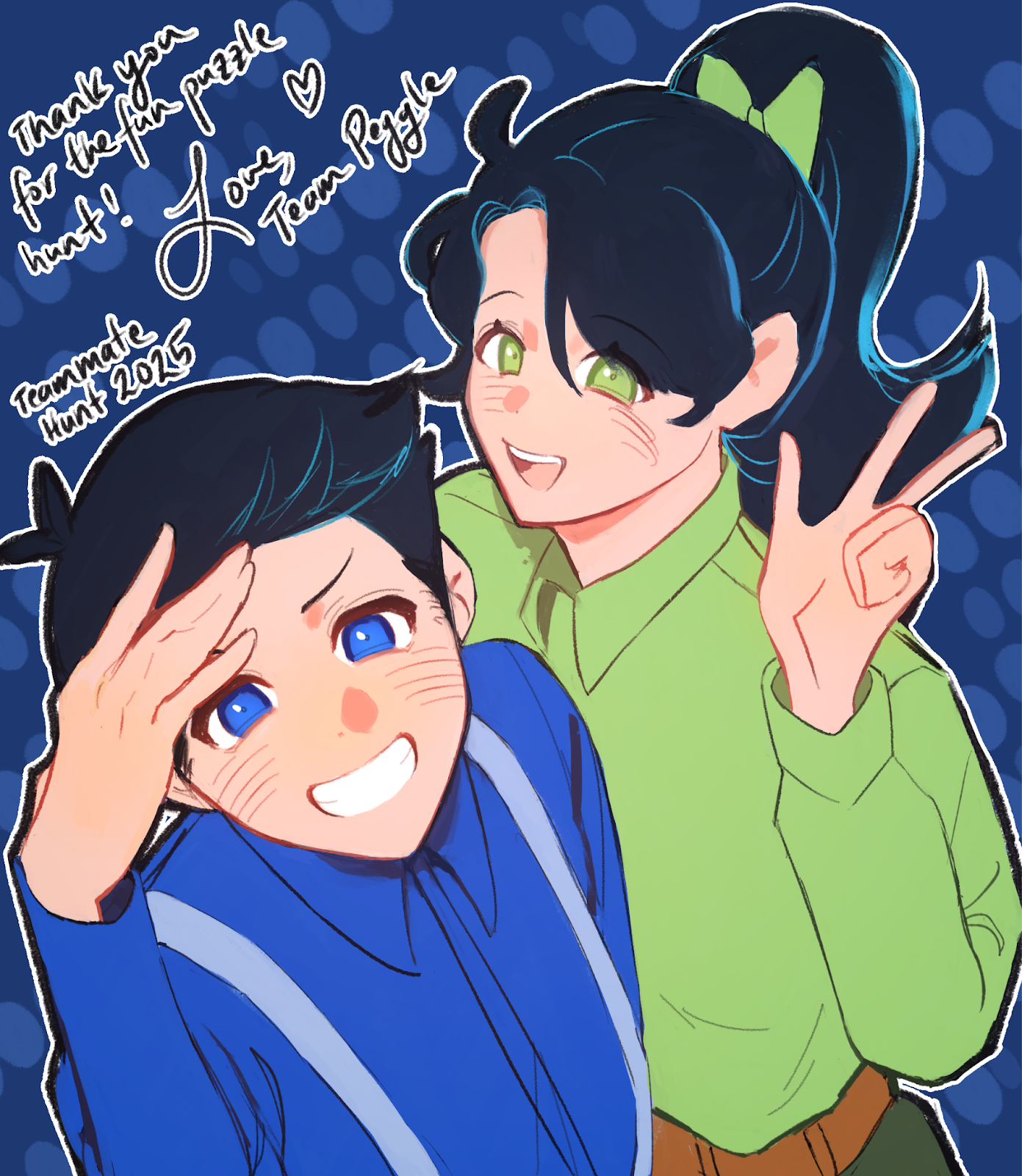
Fan art from Team Peggle!!! <3 <3 <3
Q & A
How many puzzles are there actually?
It is laughably difficult to answer this question. It depends on how you answer:
- Should the sequence rounds be counted per-minipuzzle, per-sequence, or as one big puzzle?(Decision: per-sequence, plus the final meta, so 4 puzzles for Spacewalk and 4 puzzles for Navigation)
- Should the puzzle pairs in the Control Panel count as one or two puzzles?(Decision: two puzzles)
- Should mini interactives like Where To Next count as a puzzle?(Decision: yes)
- Should locks/safes count as puzzles?(Decision: no)
- Should the hidden/pre-hunt puzzle count as a puzzle?(Decision: no)
The total count ended up as 51. But if you answer differently, it could be anywhere between 40 and 79.
Any structural ideas you're willing to share that got cut, e.g. more puzzles having secret additional answers?
To be honest, not much structure got cut! We ended up being quite close to the original proposed structure.
Why did Lucy betray the group?
She likes money. You know how much a timeium reactor core sells for on the black market?
Was there Outer Wilds inspiration for this hunt? It feels like there is.
There was! We took a lot of inspiration from how Outer Wilds gates progression via information, as well as some of the spacey vibes. Other video gamey inspirations include Among Us (ship aesthetic, vents as a secret passage) and Zero Escape (branching-narrative adventure game with time-loopy elements and puzzle sequences).
Was the general story/theme of the hunt inspired by FOURTEEN YEARS BAD LUCK from Teammate 2021?
When we finally get to Roomba’s Reign, we’ll give Matt and Emma a nice, safe hunt where nothing goes wrong - assuming, of course, they haven’t racked up more bad luck in the time since.
What was the inspiration for Podomorph language?
There were not many specific inspirations, but there were broadly two design principles. The first was to use the biology of the aliens as a starting point. The second was to break from human language patterns where possible, just to keep things interesting >:).
We had the idea of vaguely molluscoid (in my mind, I think of the central "circle" as being like a shell), rotationally symmetric, electrokinetic aliens living in a low-gravity fluid-filled environment pretty early on. Once we'd established that the podomorph's primary sense was electroreception, having the language be a sign language made a lot of sense.
The place value part of the numeral system was vaguely inspired by Incan khipu. The representation of each digit was sort of motivated by Roman numerals. We wanted two humans to together be to communicate in Blobbish, which meant we could have at most six limbs active at any given time. This led us to give the podomorphs six limbs, and make the numeral system base 6.
Hopefully this gives some insight into what we were thinking about as we designed the language! You can read more about the design and lore here.
Who did the art? Are you a professional?
We are not art professionals ;) We are just puzzle enthusiasts working in tech. We also like cats. This hunt is a purely volunteer effort on all fronts.
How did you decide on the ratio of interactables vs answerables?
We designed puzzles foremost around the story and structure, so the ratio was determined ad hoc per needs of the round. In some areas like Where to/2 Next we knew we needed quick interactive puzzles, some like the Comms Device were made interactive due to story flavor.
Is there a reason for MATT & EMMA's adventures to be in alphabetical order starting with a B? Why not A?
A was already taken by Matt and Emma’s Amnesiac Adventure (or Alphabetical Academy).
In all seriousness, Birthday Bash was chosen as a title without thinking about the titles of future teammate hunts. Carnival Conundrum was intentionally alliterative but just coincidentally in alphabetical order. This year, we didn’t constrain ourselves to only writing a D-D hunt, but it so happened that we found a name that worked to continue the pattern. Then the decision to continue the alphabetical pattern was the result of a close internal vote.
Any thoughts on "innovation power creep" in puzzlehunts? Are we in for a world where your puzzlehunt has to have 5D multiversal time travel to be interesting/relevant?
We think there is plenty left to explore in the puzzlehunt space (without needing to become increasingly complex)! “Time travel” and “choose your own adventure” are ideas that have been used in recent hunts (see our theme decision section for more details). However, we wanted to explore these tropes in our own way.
Our team was particularly interested in trying to “innovate” and expand the definition of what a puzzlehunt can look like. But that doesn’t mean all puzzlehunts need to do this!
While there is a small audience that enjoys and truly appreciates the artistry behind increasingly complex and difficult puzzles, there is perhaps an even bigger audience that will appreciate an easier puzzle with a novel twist.
Were the submissions in Make Your Own Metapuzzle personally checked and approved?
It depends what time of day you submitted - early on in the hunt and when we had the staff, we tried to have a person look at every single submission. During US nighttime hours when we couldn’t keep up with demand, we did switch submissions to an auto-accept mode. 664 Make Your Own Metapuzzle submissions were auto accepted. However, all Transmission submissions were always graded manually even if that delayed the response time.
Why the achievement system?
This decision to have achievements over a traditional leaderboard was driven by a few reasons. Due to the branching structure, there would be no “fair” way to have a time-based leaderboard. If a team makes certain arbitrary decisions first (e.g. going to Cargo Shelves or Elevator first, going to Captain’s Office or Control Panel first, etc.), they could have vastly different experiences.
We also didn’t want to have a leaderboard in order to encourage more engagement with the story. We wanted people to solve synchronously with their teams (particularly for important sections like the beginning of the hunt, the first reset, and The Reactor) and didn’t want them to feel pressured to speed ahead.
Once someone suggested adding achievements instead, everyone was immediately on-board – the structure of the hunt takes inspiration from video games, and achievements felt like a very natural addition. We generally tried to make the achievements be associated with taking certain actions in the story, rather than just for solving particular puzzles.
How long will the site continue to function?
The site will be fully functional until the site is made static. This is not likely to happen before the end of May.
Thank you for the hunt! How can we support you?
See our totally optional tip jar, used for server and other incidental costs!
